AV CONTROL IN A HYBRID

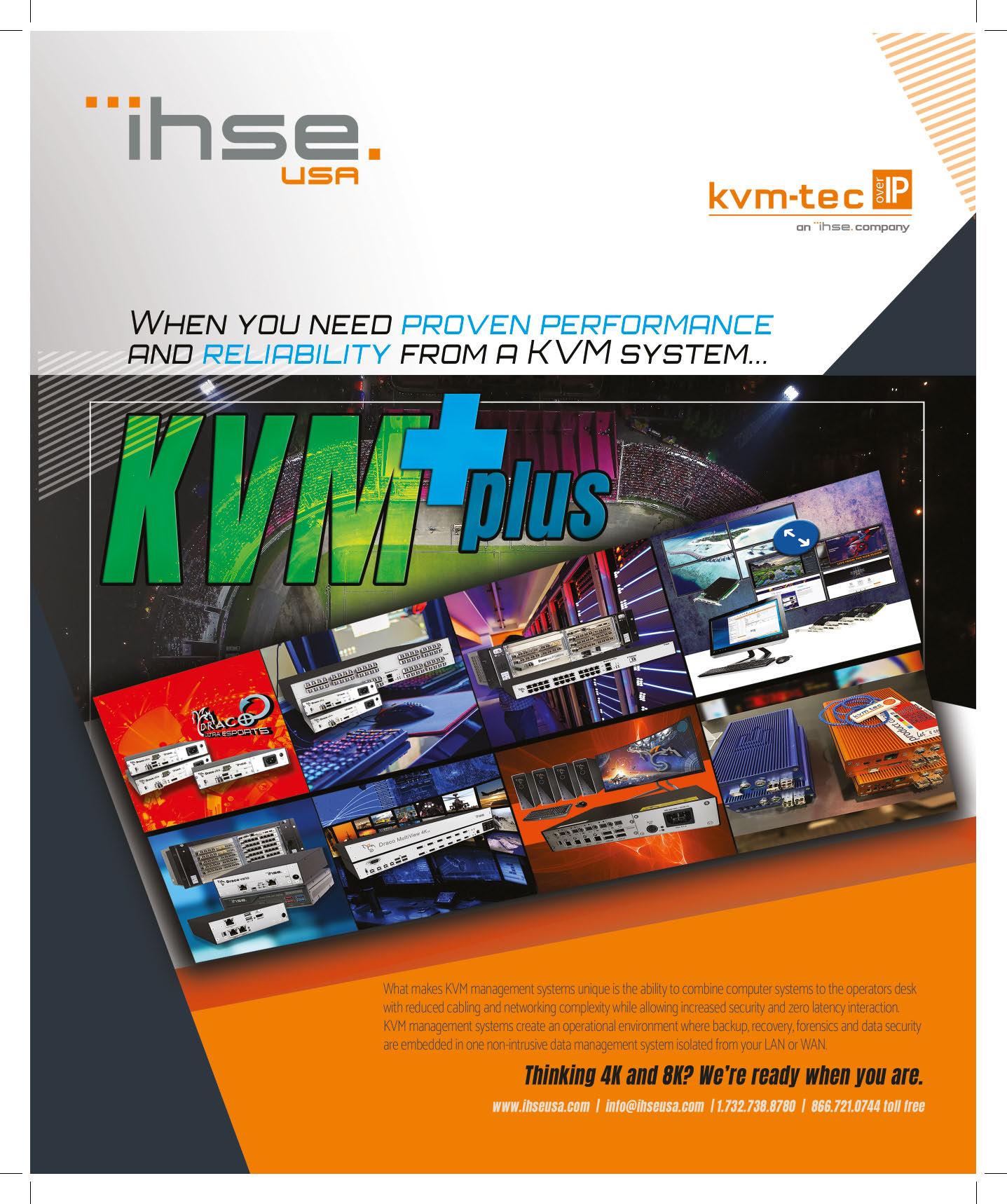




Professor Hideki Wakabayashi, director of the Department of Management of Technology, and his team at the Tokyo University of Science explored ways of connecting students and instructors virtually and quickly made classes available using Zoom, and now has hybrid learning down to a science.

08
We spoke with 23 industry experts and asked them to share their thoughts on the opportunities AV control provides in today’s environment and what developments they see on the horizon. Case-in-Point
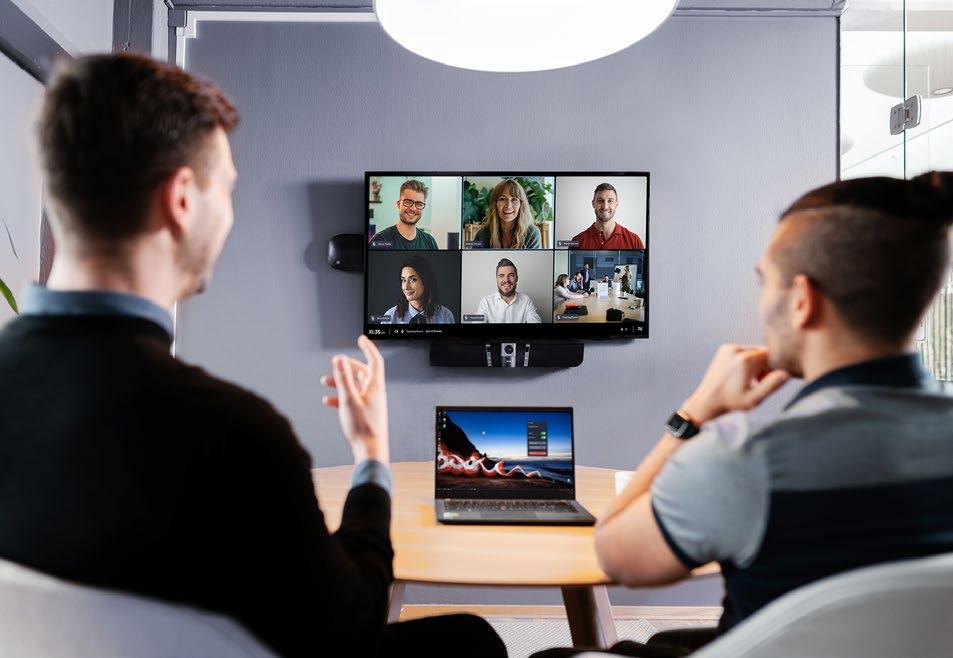
22
Video production leader EVS uses KVM (keyboard, video, and mouse) in its 12 training rooms worldwide. | Berkeley Preparatory School rolled out a 40-channel, fully networked audio solution that can be managed offsite. | Warren County Public Schools district chose a platform that protects and prioritizes teachers’ wireless connections. | The University of Manchester Engineering Campus Development added 2,200 learning, meeting, and social spaces, creating a highly flexible teaching and research environment.
Eighteen AV/IT enterprise and campus-worthy products are in control.
28
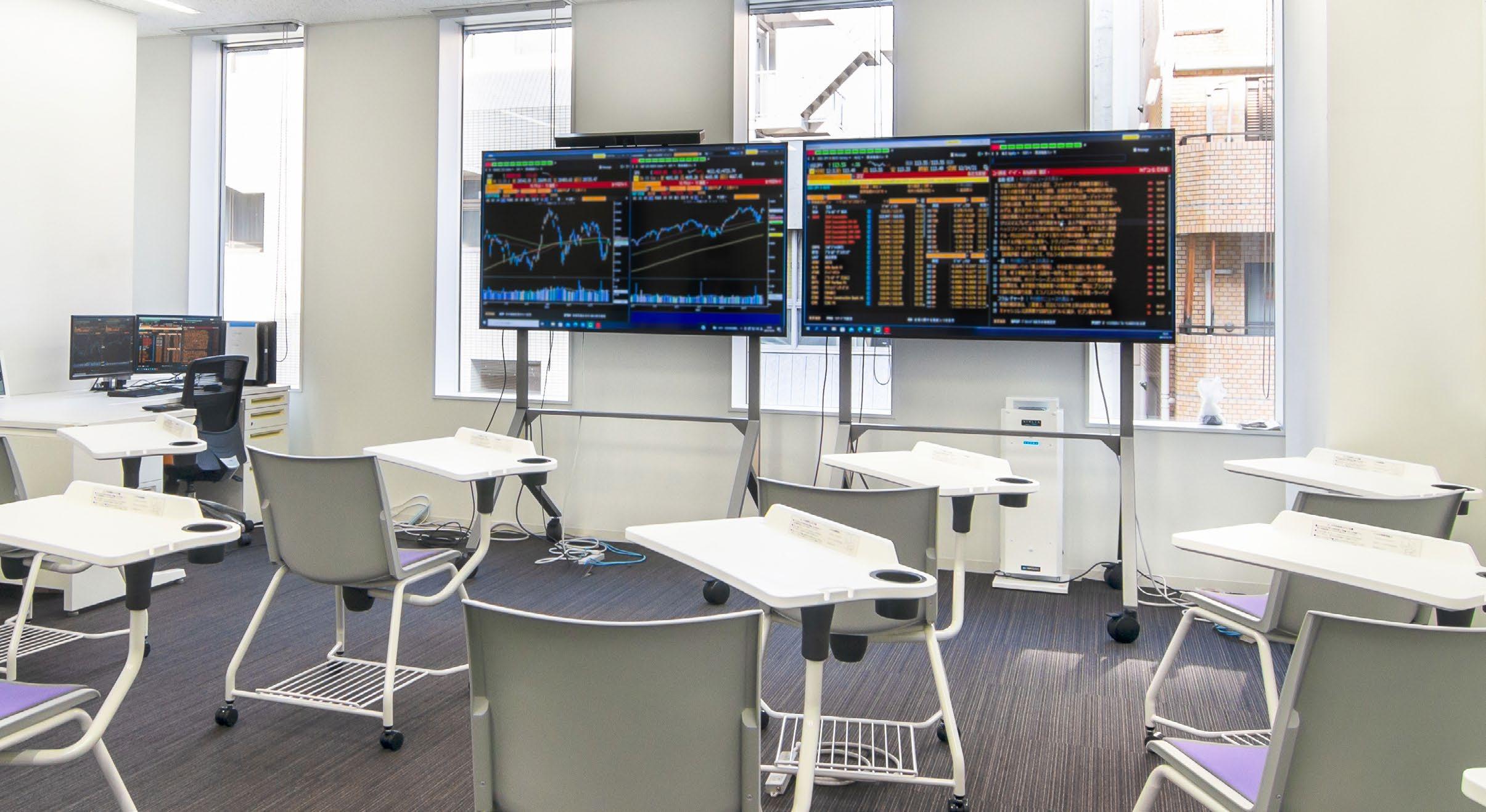
1 Hassle-freeStart
Joinmeetingswithone-touch. Move meetingsto anywhere.
2 AwesomeView
Built-in4Kcamera and opticalPTZcamera delivers fantasticviewwithgreat color. Al-powered features suchasAuto Framing andSpeaker Tracking enables peopleto see without distraction.
3TrueVoice
stereo microphonesand speakerssupports 12mfull-duplexaudio. Al-enhancednoise cancellation andreverberationsuppression makesthe voice crystal clear.
4 InstantShare

Plug-and-share, without anyother configurationsteps.
5 Ideas Flowing
Brainstormtogetherwith ashard whiteboard.
Scan

Discover more andcontactYealinksales: https://wwvv yealink com/en/product-detail/microsoft-teams-rooms-meetingboard65

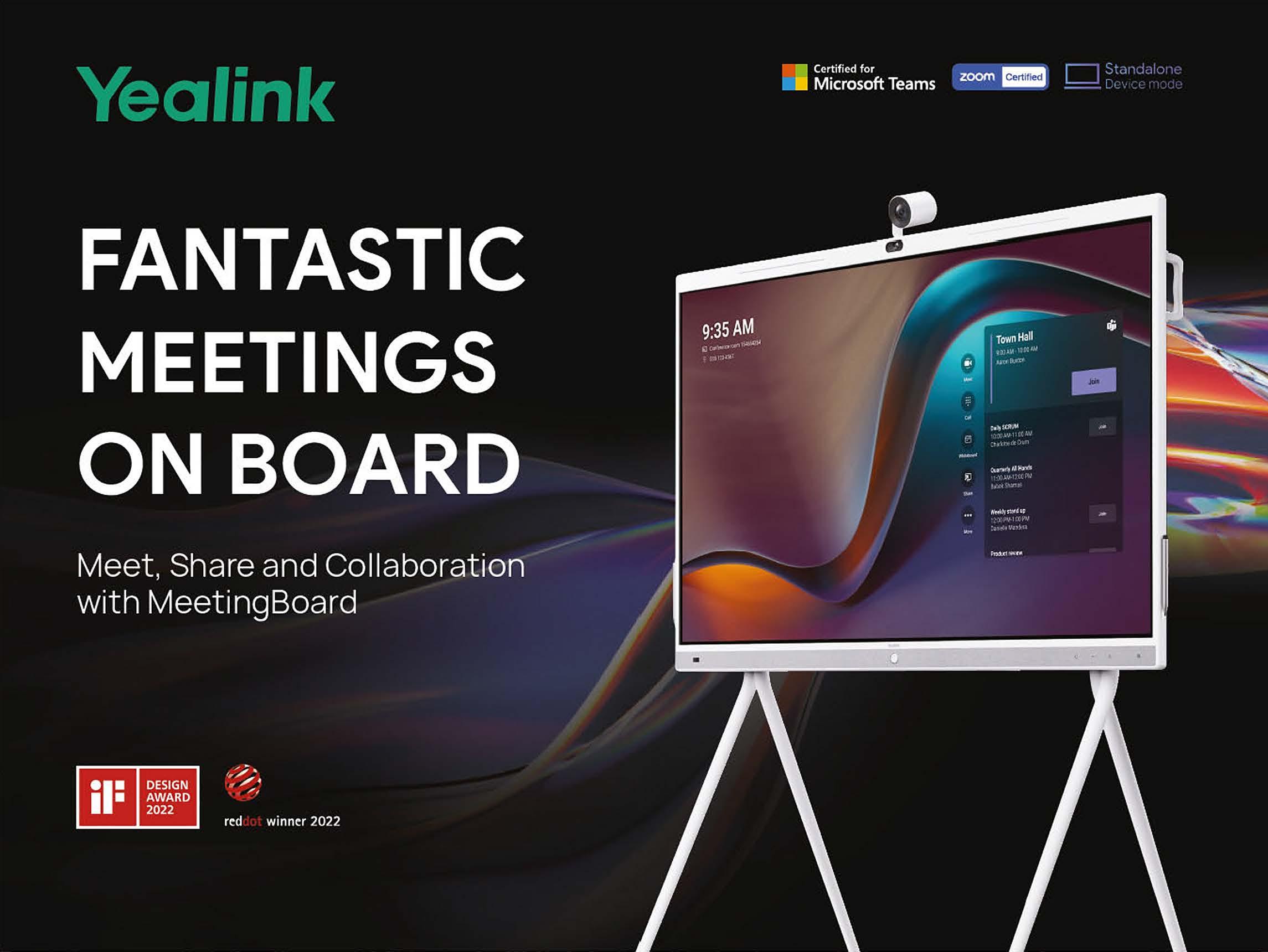
CONTENT

VP/Content Creation, Anthony Savona
Brand and Content Director, Cindy Davis, cindy.davis@futurenet.com

Contributing Writer, Macy O’Hearn
Managing Design Director, Nicole Cobban
Design Director, Sam Richwood
Production Managers Heather Tatrow, Nicole Schilling
ADVERTISING SALES
Managing Vice President of Sales, B2B Tech
Adam Goldstein, adam.goldstein@futurenet.com, 212-378-0465
Janis Crowley, janis.crowley@futurenet.com, 845-414-6791
Debbie Rosenthal, debbie.rosenthal@futurenet.com, 212-378-0473
Zahra Majma, zahra.majma@futurenet.com, 845-678-3752
SUBSCRIBER CUSTOMER SERVICE
To subscribe to AV Technology or Future’s other AV industry brands, go to https://www.smartbrief.com/subscribe
LICENSING/REPRINTS/PERMISSIONS
AVTechnology is available for licensing. Contact the Licensing team to discuss partnership opportunities. licensing@futurenet.com
MANAGEMENT
SVP Wealth, B2B and Events, Sarah Rees
Managing Director, B2B Tech & Entertainment Brands, Carmel King
Managing Vice President of Sales, B2B Tech, Adam Goldstein
Head of Production US & UK, Mark Constance Head of Design, Rodney Dive
UNTIL THREE YEARS AGO, room-level and enterprise-wide control of AV was a very nice to have, and we all know the benefits. But I can’t think of a time when AV control was more critical. First, AV control helps ensure business continuity, regardless of company or institution. Secondly, AV/IT control helps enable remote collaboration and the hybrid workplace. Many companies are trying to lure or demand that workers return to the office, which is proving harder than CEOs expected. The economic downturn hasn’t scared the workforce back into the office in fear of losing their job. Some of the reasons employees cite for not wanting to go into the office are that their home technologies are easier to use, or when they go into the office, it’s often to sit at a desk and sometimes still communicate with the person in the next office via Teams or Zoom.
Finally, AV control can and should provide an enhanced user experience.



We spoke with 23 industry experts and asked them to share their thoughts on the opportunities AV control provides in today’s environment and what developments they see on the horizon. Here are some snapshots.
vice president of Sales and Marketing at Hall Technologies. “This allows employees, students, and faculty members to share ideas, present information, and engage in interactive discussions effortlessly. With streamlined control interfaces and intuitive, user-friendly systems, AV control simplifies the process of managing multiple devices and content sources, fostering effective collaboration and knowledge exchange.”
Dan Holland, marketing manager at IHSE USA, said, “For professional AV and related industries, workflow is tremendously improved when operators can share multiple computer sources—regardless of whether they are centralized or located across the globe. For instance, data analysts and video production editors can work from a single workstation while accessing computers, no matter where they may be located. This saves space on the desktop and adds convenience for users since they do not have to leave their desk to access multiple computers.”
If you submit material to us, you warrant that you own the material and/or have the necessary rights/permissions to supply the material and you automatically grant Future and its licensees a licence to publish your submission in whole or in part in any/all issues and/or editions of publications, in any format published worldwide and on associated websites, social media channels and associated products. Any material you submit is sent at your own risk and, although every care is taken, neither Future nor its employees, agents, subcontractors or licensees shall be liable for loss or damage. We assume all unsolicited material is for publication unless otherwise stated, and reserve the right to edit, amend, adapt all submissions.
“Through this remote connectivity, IT professionals and remote managed service providers can now tap into the system over the internet to configure systems and manage devices or offer real-time troubleshooting and help desk assistance,” said Robert Bird, product marketing manager at Atlona.
“One of the most important benefits of AV control in these [new era] environments are improved collaboration,” said Hal Truax,
“With the increased adoption of remote work and hybrid campus environments, a comprehensive AV control system plays a crucial role in facilitating communication and collaboration,” said David Missall, insights manager, Business Communication at Sennheiser. “If the AV setup stretches across various buildings and several collaboration spaces, being able to centrally manage this instead of physically supervising and troubleshooting devices can be incredibly valuable.”
Read the full interviews from these industry experts, plus 19 more, starting on page 08.

The Tokyo University of Science, located in Kagurazaka, Tokyo, is one of Japan’s leading science and technology universities. The Department of Management of Technology (MOT) is the graduate-focused program within the Graduate School of Management. Working closely with students, MOT fosters the next generation of advanced professionals to integrate science, technology, and management principles in response to the rapid changes in society and business today.
In response to pandemic restrictions on teaching in person, Professor Hideki Wakabayashi, director of MOT and his team explored ways of connecting students and instructors virtually and quickly made classes available using Zoom, ushering in MOT’s hybrid classroom approach. In this flexible learning environment, both in-person and online classes were held at the same time.
Professor Wakabayashi recalled, “Initially, we started classes using the cameras with laptop microphones, but the sound clarity for the far end was not good enough.” He continued, “Through trial and error—such as installing multiple desktop microphones where we thought more would make the audio better—we realized we needed a solution that would provide clear, intelligible audio while also capturing the movement of the professors and show the whiteboards clearly.”
As a university committed to diversity, MOT attracts students from a variety of backgrounds and experiences, many holding positions at leading companies in Japan. Also among the students are retired individuals who continue to deepen their knowledge while sharing their own professional experience.
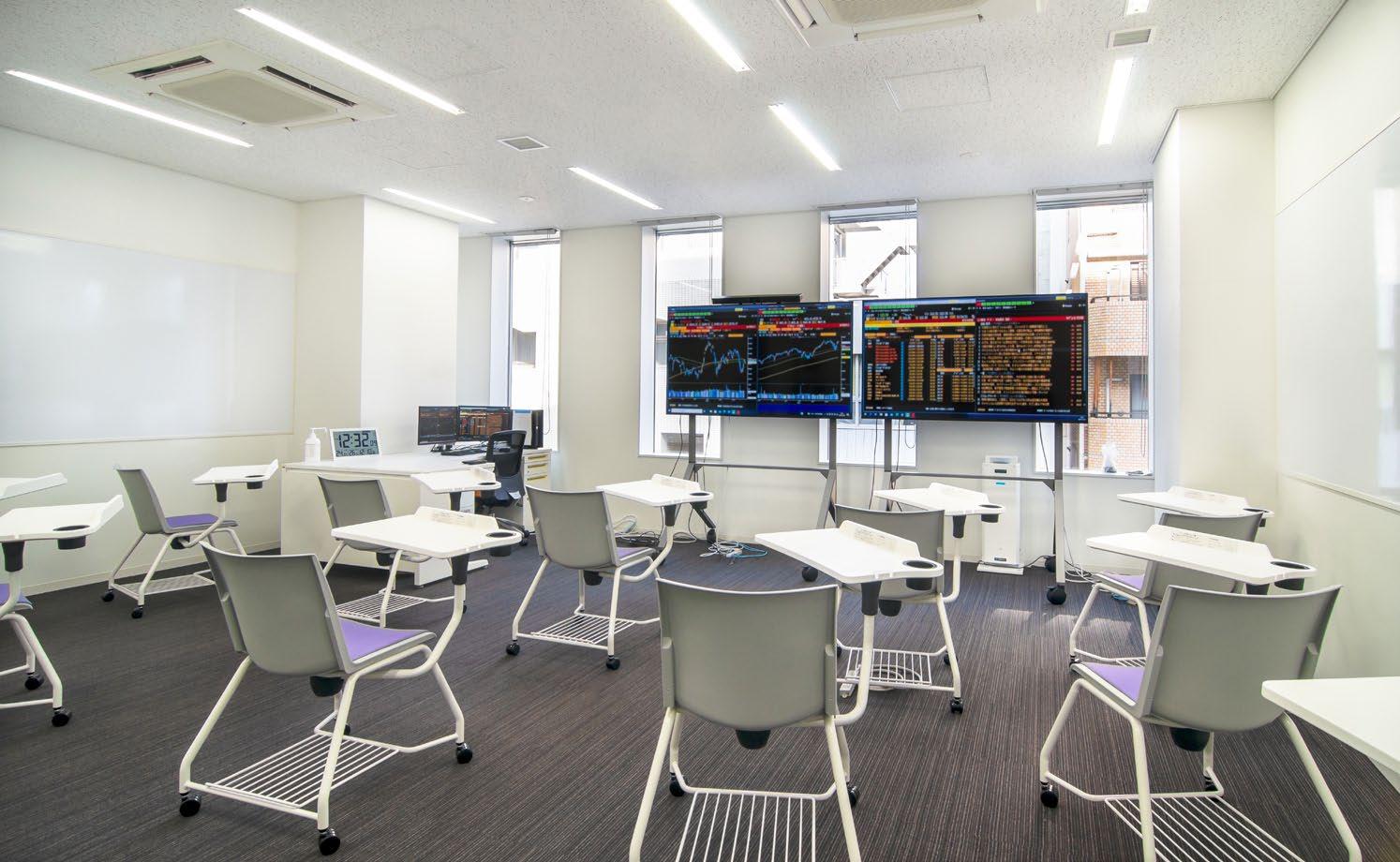
Since lectures are held mainly in the evenings and on Saturdays, students can travel to MOT from outside the central Tokyo area. MOT is a gathering place that welcomes all to learn from its distinguished professors. In addition to expanding one’s knowledge, the intellectual environment and exposure to differing values creates a unique learning environment—reinforcing the importance of clear communication for both MOT and students.
One of the most challenging aspects to the hybrid classroom approach for Wakabayashi
With help from two industry leaders in collaboration technology, this graduate-focused university department now has hybrid learning down to a science.
A diverse student body with diverse learning needs meant that MOT required powerful and hybrid-capable— yet seamless and user-friendly— AV solutions.
offered both Bose-quality audio and ultra-HD clarity for online communication.
“The energy of the classroom is now shared with those who participate via Zoom,” Wakabayashi stated. “Our desire to have transparent technology created a sense of unity by eliminating the barrier between online and in- classroom learning.”
Thanks to the 4K ultra-HD camera, microphone and loudspeaker, MOT now has a superior, high-quality AV solution that delivers a seamless, flexible learning experience. The distribution system enabled professors to deliver high-value, quality lectures with guest speakers to a wider audience, since the number of participants is no longer limited to in-person students.
While hybrid learning has its challenges, MOT has turned the situation into one with lasting benefits. Now MOT can provide the option of both in-person and remote learning in perpetuity, which provides an opportunity for even more inclusivity and diversity by allowing students who work or those located outside of Japan to enroll. Because of the virtual aspect, professors can also record the lecture, which includes both classroom and chat discussions, providing an archive for on-demand learning.
and his team was bringing the excitement and energy students experienced in the classroom to everyone attending classes online. It was clear the university needed an audiovisual solution that captured and conveyed the lively discussions, while nurturing and motivating remote students to learn and participate.
Sony Marketing Corporation—a Bose Professional partner dealer and one of Japan’s leading technology companies—responded to MOT’s unique needs. Sony installed its latest AI technology camera, which enabled automatic tracking of the professor and clear video delivery of the whiteboards. Sony ceiling microphones provided the necessary audio quality for both in-classroom speech reinforcement and online distribution, while providing a more hygienic solution than handheld mics.
In combination with the Bose Professional Panaray MSA12X steerable array loudspeakers that elevate speech intelligibility, the solution provides natural amplification with minimal feedback throughout the fan-shaped theater classroom. At the core of the system is the ControlSpace EX-1280C conferencing sound processor, which distributes clear audio to online students via a connected PC, creating the sense of a unified classroom. The hardware collaboration between Bose Professional and Sony, as well as the on-site acoustic room tuning by engineers from both companies, exceeded MOT’s requirements. The hybrid classroom was a complete success.
For the smaller room used primarily for group discussions and the mid-sized classroom where students learn about stock price movements, the team installed the Bose Videobar VB1 all-in-one USB conferencing device to provide an intuitive solution that
Wakabayashi sees additional potential in the hybrid classroom solution made possible by Sony and Bose Professional. “It’s a great advantage to have solutions with both video and audio, and to be able to propose custom solutions for each learning space,” Wakabayashi explained. “I hope the knowledge gained at MOT will be further disseminated. For MOT students, learning is both an intellectual endeavor and entertainment. It is possible to deliver the entire lesson online with greater context using the power of technology.”
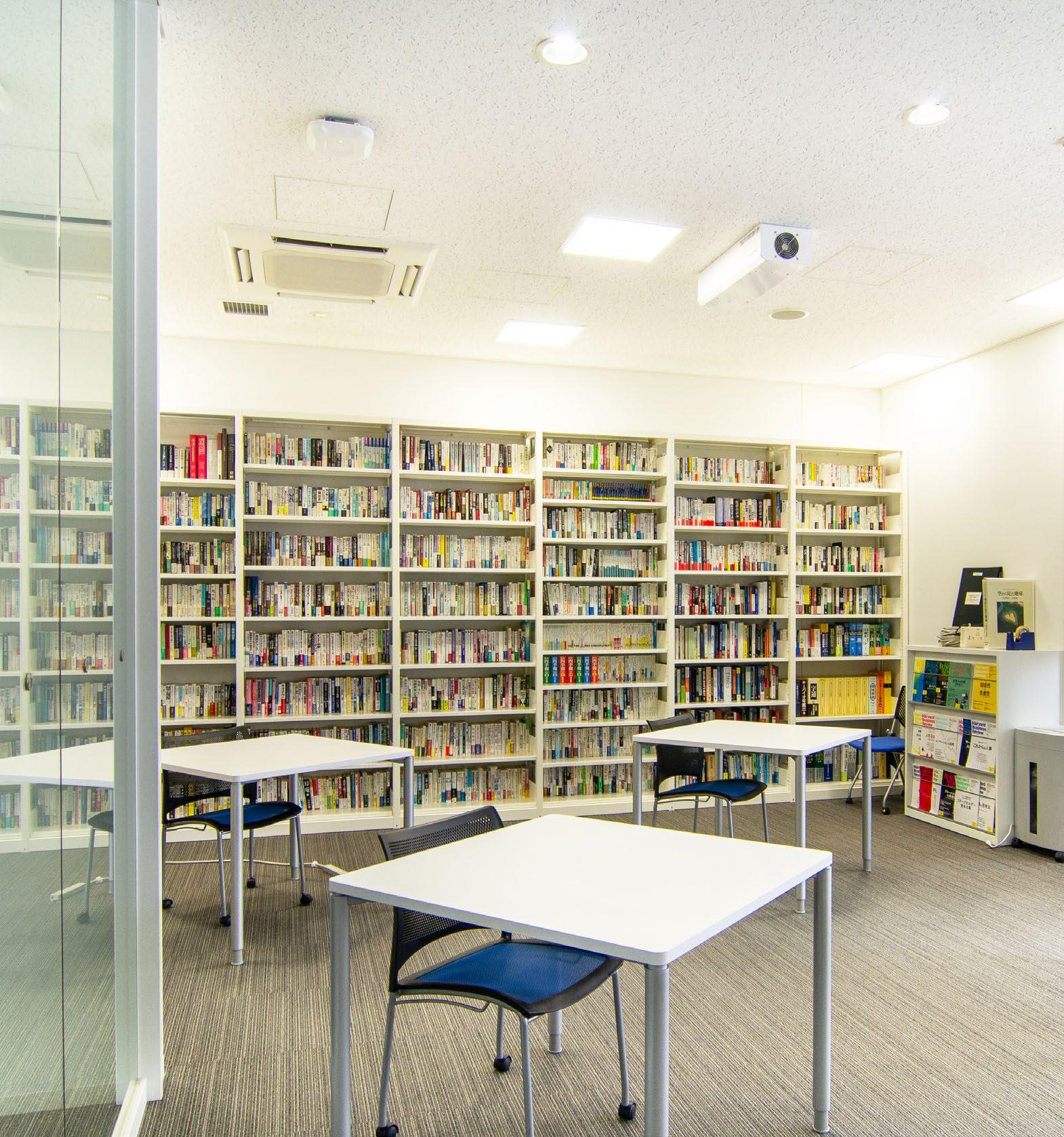
Wakabayashi continued, “I also feel that the more we expand the online aspect of our lives, the more we will realize and value the preciousness of experiences and encounters in real, actual places.”
The ideal educational environment for the next generation is cutting-edge video and audio technology that is intuitive and can amplify the excitement and enthusiasm of the classroom— both onsite and online. MOT has taken a leading step toward realizing this new future.
The new era workplace and campus environment is—at least some of the time—not a physical place at all, and every passing post-pandemic year sees hybrid learning and work gain a stronger foothold.
Manufacturers are rising to the challenge of providing education and enterprise users with powerful, versatile, yet uncomplicated AV control solutions that can accommodate remote meeting participants, streamline complex tasks, and manage a growing ecosystem of devices both in and out of the office.
We spoke with 21 industry experts and asked them to share their thoughts on the opportunities afforded by AV control in today’s environment, and what developments they see on the horizon.


The pandemic fueled a wave of change and innovation in collaboration technology, both in the workplace and on the higher education campus. As businesses and schools resumed physical operations, it became clear that hybrid strategies were necessary. This required a technological shift inside meeting and learning spaces, where AV systems now had to accommodate both in-person and remote participants in meetings and lessons. We now see cameras and microphones inside these spaces to help remote attendees collaborate as equal participants to those in the room. We see more displays inside these spaces as well, which allow physical participants to follow their peers who are dialing in from remote locations.
The influx of new technologies increased the complexity of AV systems, and companies like Atlona are tasked with making these sophisticated spaces easy to use. Users need to be able to walk into a room, connect their laptop or access the room computer, and immediately start presenting to both physical and remote participants.
Atlona innovations in occupancy sensors, input status, and automatic display control built into our Velocity control and Omega switching solutions help achieve this ease of use. Now, the AV system can automatically start up with the appropriate settings when walking into a room, plugging in a source, or touching a single button on a touch panel.
This new era of control has also created opportunities for enhanced system setup, maintenance, and support. Atlona recently unveiled a new service that provides remote access to enterprise and campus-wide control systems, which can both reduce costs and accelerate responsiveness in comparison to rolling a truck to the site or dispatching a technician to the room. Through this remote connectivity, IT professionals and remote managed service providers can now tap into the system over the internet to configure systems and manage devices, or offer real-time troubleshooting and help desk assistance.
HAL TRUAX Vice President of Sales and Marketing Hall Technologies

AV control plays a crucial role in enhancing productivity, collaboration, and overall user experience in new era workplace and campus environments. With rapid advancements in technology, AV control offers myriad benefits that significantly impact these settings, creating seamless and efficient work and learning environments.
One of the most important benefits of AV control in these environments is improved collaboration. AV control systems enable easy connectivity and integration of various audio and visual devices such as projectors, displays, speakers, and video conferencing equipment. This allows employees, students, and faculty members to share ideas, present information, and engage in interactive discussions effortlessly. With streamlined control interfaces and intuitive, userfriendly systems, AV control simplifies the process of managing multiple devices and content sources, fostering effective collaboration and knowledge exchange.
Another key advantage of AV control is the enhanced user experience it provides. These systems offer centralized control, allowing users to easily adjust audio levels, display settings, and room lighting, among other features. This level of control ensures that presentations, lectures, and meetings are conducted in an optimal environment, maximizing engagement and comprehension. Additionally, AV control facilitates accessibility and inclusivity by providing customizable options for individuals with special needs, ensuring that everyone can fully participate and benefit from workplace or campus activities. AV control also contributes to increased efficiency and productivity. By automating routine tasks and simplifying complex operations, it saves valuable time and eliminates technical glitches that may disrupt workflows. For example, the ability to schedule and automate audio and visual equipment enables seamless transitions between different activities, eliminating the need for manual setup and reducing downtime. Moreover, remote management capabilities allow IT teams to monitor and troubleshoot AV systems from a central location, minimizing maintenance delays and ensuring uninterrupted operations.
DAN HOLLAND Marketing ManagerIHSE USA
For professional AV and related industries, workflow is tremendously improved when operators can share multiple computer sources—regardless of whether they are centralized or located across the globe. For instance, data analysts and video production editors can work from a single workstation while accessing computers, no matter where they may be located. This saves space on the desktop and adds convenience for users since they do not have to leave their desk to access multiple computers.
Signal management across the network remains a complex and sometimes difficult process when trying to create a solid pointto-point connection with the latest highperformance video and data requirements. In computer networks, bandwidth is synonymous with performance, and unfortunately much of today’s network data transfer rates are still measured in bits per second, while digital video is measured in gigabits per second. Limited bandwidth affects performance and AV system designers must calculate for packet loss, latency, and jitter throughout the full ecosystem.
This concept is further complicated with IPbased video access to virtual machine servers. Using virtual machines allows users to access a virtual source remotely via the network using RDP or VNC sessions. However, a major difference that IHSE offers is that the user has actual control of the computer as if it were physically connected to an IHSE KVM Display Management Switch (DMS).
Whether it’s a graphics editing room, network operations center, or critical access command and control rooms, the DMS Systems allow access to any virtual computer from anywhere. DMS switch components are more ideal for direct access to a computer without requiring a mapping of a session that runs on top of the operating system. DMS virtual access acts as a thin-client linked directly to the hardware level, which is much more stable and offers the best performance for ultra-fast keyboard and mouse commands.
There are a plethora of benefits to AV control in the new era workplace and campus environment. First and foremost, a control system allows for unprecedented ease and uniformity in handling multiple unique pieces of AV technology. As we begin incorporating more advanced pieces of individual tech in workplaces and campuses, it is becoming even more important to have a singular device that can control them all—lights, microphones, projectors, or any other AV equipment. A control device allows us to access these various individual pieces from one place, allowing for on-the-fly changes, updates, troubleshooting, and additions without having to be a tech genius. This can help both companies and educators save time, capital, and unneeded stress when dealing with their AV equipment.
We find ourselves fully immersed in the digital age of AV, meaning long gone are the days of having or needing all participants to be physically present for a meeting or lecture. While this freedom provides a level of accessibility previously unheard of, it also means increased variability in the equipment being used by participants, and a decreased chance that someone knowledgeable about the AV equipment will be physically present if something happens. Luckily, remote access control panels mean troubleshooting and interface access can be achieved from anywhere. Having a control device becomes crucial to ensuring that a virtual meeting or lecture runs without a hitch in case of unforeseen technical difficulties.
Additional benefits range from increased security to increased building maintenance control, to preemptive readying of rooms for changes in setup or format. Needless to say, AV control is highly beneficial in its ability to accommodate the new norms of the workplace and campus environment.
JOHN HULEN Director of Channel Marketing, Education Crestron

Since our education solutions are my area of expertise, I’ll address the campus environment.
The first benefit is improving and simplifying the communication of the course material from faculty to students by using automation to control classroom technology. Single-touch controls that can execute multiple commands at once and give the user automated scenes for the room’s systems are optimum. (We even have one client that created a “help” overlay that appears on the touchscreen with the touch of a button, should the user need a little extra assistance.)
The second benefit is providing a consistent, reliable, and repeatable user experience across different learning environments which can be understood and used without technical training. This is why you’ll want to make certain that you’re providing faculty, staff, and guest lecturers with a user experience that makes the technology completely intuitive.
The third benefit is allowing for scalable solutions, no matter what type of learning or recreational spaces need to be controlled across campus. Having a single standardized platform that can repeat a given solution is invaluable. Some of our customers have had great success taking a fairly basic program and expanding or contracting it to fit a particular room’s technology requirement.
And finally, AV control allows for the provisioning, deployment, management, monitoring, and support of classroom technology from anywhere on campus. The right system can anticipate issues before a lecturer even sets foot behind a lectern.
Simply put, the goal should always be about creating tech solutions that let teachers teach—and never forcing them to concern themselves with troubleshooting the devices or system in a given room.

C2G, Legrand I AV AV control offers significant advantages in modern workplaces and campus environments, particularly in the context of hybrid work and learning. As the demand for audio-video signal aggregation increases, along with the prevalence of multiple cameras in a space, the management and control of these diverse sources become more intricate. Furthermore, the advent of platforms like Microsoft Teams Rooms or Zoom Rooms adds another layer of complexity.
Most end users are not comfortable navigating through complicated AV switching systems. Consequently, AV integrators and IT/facilities managers are tasked with finding solutions that enable room users to operate the space effortlessly. In this regard, an AV controller becomes an indispensable tool for enterprise and campus applications.
Room users are accustomed to userfriendly interfaces and applications in their personal lives, and they expect a similar experience at work or in school. The key advantage of an AV control system lies in its ability to consolidate all the intricate systems operating behind the scenes into a single, user-friendly interface. This eliminates the need for users to interact with a stack of remote controllers or complex equipment. With a simple press of a button, users gain control over not only the room’s various equipment, such as monitors, projectors, and cameras, but also room functions such as lighting, shades, or climate control.
The market offers a wide range of AV controllers to accommodate different needs and budgets. From straightforward pushbutton wall plates to advanced digital touch panel devices, there are options available for every requirement. Higher-end touch panel controllers are ideal for conference rooms because of their networking capabilities, which allow additional features such as room scheduling. On the other hand, education settings often find a simple push-button wall plate to be sufficient for their needs.


Audinate InfoComm offered an important opportunity to showcase the continued evolution of our powerful, interoperable Dante networking platform. It also marked another critical milestone for Dante AV—our industry-leading professional AV-over-IP video solution—as we introduce our latest member of the family, Dante AV-A.
The Dante AV family of products includes Dante AV Ultra, a hardware-based solution offering 4K60 video encoding and decoding for high-quality, visually lossless video; and Dante AV-H, an embedded software solution that OEMs can add to their Ethernetenabled H.264/H.265 cameras, encoders, and decoders, turning them into Dante AV endpoints.
We have seen incredible interest in the platform from manufacturers and customers alike. We now have more than 30 OEMs licensing Dante AV with brands such as AJA, Marshall, and AMX by Harman building networked video devices and creating a product ecosystem of cameras, encoders, and decoders.
Now OEMs have another Dante AV option to consider: Dante AV-A. In partnership with ASPEED Technology, we extended Dante AV to its popular AV-over-IP chipset, naming it Dante AV-A. The new version has been optimized to work on the ASPEED AST1530/1535 SoC (System on Chip) and is supported by nine leading AV manufacturers. It delivers highquality video up to 4Kp60 4:4:4 resolution, and two channels of Dante audio that are instantly compatible with Dante audio products, simplifying distributed AV system design.
In addition to Dante AV-A, we’ll have a complement of our manufacturer-agnostic network management tools on display, including Dante Connect, a recently launched solution that allows Dante audio to be distributed worldwide using cloud service providers like Amazon Web Services.
I am also particularly excited to see the Dante AV ecosystem continue to grow and look forward to announcements from our ecosystem partners at InfoComm.
With the increased adoption of remote work and hybrid campus environments, a comprehensive AV control system plays a crucial role in facilitating communication and collaboration. The meeting room or classroom is no longer limited to physical meeting spaces; therefore, we must maintain complete AV control to support productivity, engagement, and connectivity. With a holistic view of all deployed AV technology, AV teams can better ensure that both remote and hybrid participants can experience seamless communication across audio and video conferencing platforms. AV control solutions can also support inclusivity and accessibility by supporting features such as captioning and transcription for those operating with impairments or language barriers.
With this, for large corporate or education campus deployments, AV teams save time and resources by managing the audio from a centralized location. If the AV setup stretches across various buildings and several collaboration spaces, being able to centrally manage this instead of physically supervising and troubleshooting devices can be incredibly valuable.
“In partnership with ASPEED Technology, we extended Dante AV to its popular AV-over-IP chipset, naming it Dante AV-A.”
—Joshua Rush Chief Marketing Officer Audinate
“With a holistic view of all deployed AV technology, AV teams can better ensure that both remote and hybrid participants can experience seamless communication.”
—David Missall Insights Manager, Business Communication Sennheiser

We’ve been doing a lot of training at universities, and most of the time we are talking about AV over IP. They love the concept; it has no limitations. You can add equipment to any individual classroom and put any campus-wide classroom onto the same network. This gives campus-wide AV control, so if you happen to be off site that day, you can control everything from wherever you are.
The challenge is the need for a huge database of support infrastructure so you can keep track of all the room devices. You can remotely track and control all the power supplies in each room and even have them turn on/off at selected times to support a green initiative. A cloudbased system that allows access to search for each device is ideal, and now with everything on the network, it’s much easier to do that.
But a big advantage is the flexibility AV over IP provides. If you have 200 people for a 50-person classroom, you can easily send video and audio to multiple overflow locations. You can send emergency notifications instantly to every display if there’s a dangerous weather event, complete with directions on what to do.

As much as technology has evolved in the 40plus years that AMX has been advancing AV control systems, the goal we strive to achieve with our work remains the same. Our mission is, and always has been, to create solutions that simplify the experience of interacting with technology. Creating an environment where technology helps users collaborate, create, and enjoy their workplace rather than one where the technology is a hurdle to overcome is the key benefit of a welldesigned AV control system.
Today, of course, technology in the workplace is far more complex and central to our ability to perform than ever before. To support today’s mobile workforce or remote student population, meeting spaces often include multiple displays, multiple audio and video inputs, microphone and camera tracking for presenters, and various sensors to monitor occupants.
In the past, integrating all that AV hardware and creating a single UI to control it was all that was required from AV control. Now, however, controlling AV hardware is the easy part. Interacting with the cloud-based conferencing software, scheduling systems, and other applications that have become crucial to organizing and connecting mobile and remote users is where one AV control system can set itself apart from the rest.
At AMX, we’re making it easier to integrate these new software systems by creating solutions that are more open and integrate more standard technologies than ever before. Our next-generation automation platform is capable of simultaneously processing multiple scripting languages and supporting nocode and low-code capabilities, opening the possibilities for technicians and IT managers of all skill sets to deliver advanced automation using the tools that they’re most comfortable using. And, we’re growing our already robust manufacturer partnership program to include many of the most popular software developers—both to ensure that our products work together flawlessly and to campaign for features that will benefit our customers.
“A big advantage is the flexibility AV over IP provides. If you have 200 people for a 50-person classroom, you can easily send video and audio to multiple overflow locations”
—Alan Jacobson Solutions Engineer Legrand | AV
“Our mission is, and always has been, to create solutions that simplify the experience of interacting with technology.”
—Jamie Trader Vice President, GPLM Video and Control Harman ProfessionalJOHN GARMENDI Senior Manager, Sales Engineering Sony Electronics

There are numerous important benefits that AV control offers to enterprises and universities. The centralization of multiple disparate pieces of technology is one of the primary advantages. Of course, accessibility is a critical feature of AV control systems, which enables adjustments to be made easily and with immediacy to enhance and fine tune each meeting or classroom interaction. This provides participants with optimal audio and visual experience, allowing them to make the most of their time together. It also offers a seamless and efficient technology experience that can enhance collaboration and engagement with minimal setup. This allows attendees to concentrate on the topic at hand, as opposed to troubleshooting technological aspects. As our society and our customers look for sustainable solutions to help contribute to a better tomorrow, AV control systems
provide a range of mindful features such as room automation which can enable power efficiencies through HVAC and lighting, as well as the ability to save energy by turning off devices that aren’t in use.
Another benefit is customization—the ability to tailor your equipment to suit your use case and audience. Finally, the insights an AV control system provides can be invaluable to a business or school. AV teams can monitor performance and can get a better
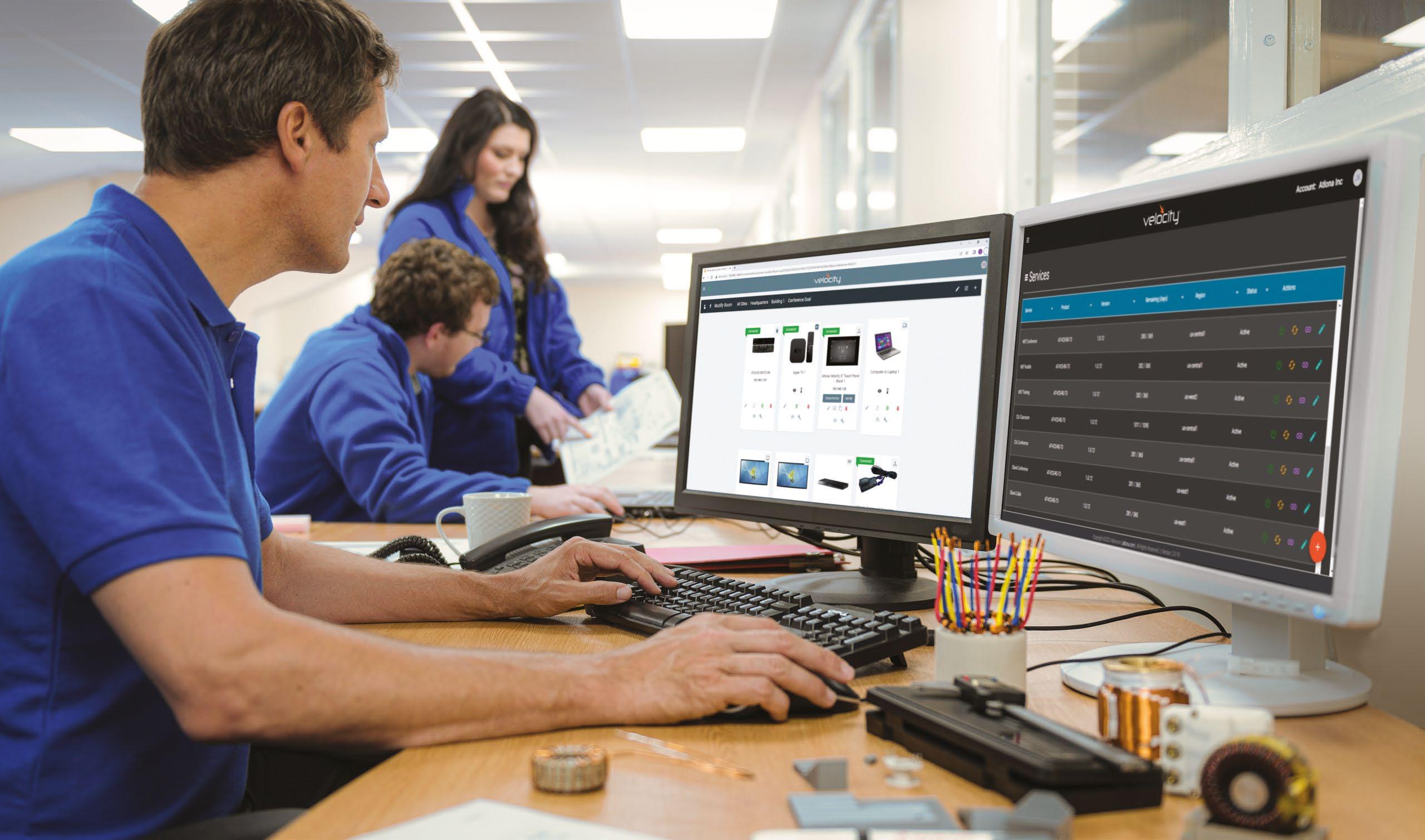 Electronics
Electronics
understanding of the current lifecycle of their products, which has the potential to reduce the need for service and support and maintain maximum uptime. At Sony, we’re proud to align with many of the top AV controllers, all of which offer robust support and compatibility with our projectors, displays, and cameras. From Crestron, Extron, Kramer, and Aurora to Q-SYS, Utelogy, Biamp, and Atlona—we’re prepared with solutions that work with our customers’ infrastructure and needs.
“AV teams can monitor performance and can get a better understanding of the current lifecycle of their products, which has the potential to reduce the need for service and support and maintain maximum uptime.”
—John Garmendi Senior Manager, Sales Engineering SonyJENNIFER ADAMS Senior Director, New Product Introduction

HP | Poly
AV control systems play a crucial role in optimizing hybrid work environments by providing standardized, secure, and userfriendly tools for effective communication and collaboration. At Poly, an HP company, we offer cutting-edge AV technology that empowers organizations in this new era. Solutions such as the Poly Lens App, which helps manage devices; and the TC10 touch control panel, which makes onsite room scheduling a breeze, enable efficient collaboration across various working environments.
One key benefit of AV control is scalability. As organizations grow, AV control solutions can easily scale with them, eliminating the need for makeshift or expensive, outdated installations in every meeting room. These solutions are designed to be easily installed and updated as new AI-driven software becomes available. Additionally, new certifications from meeting providers like Zoom and Microsoft Teams ensure secure and productive collaboration, while customization options allow IT managers to tailor spaces to their organization’s unique needs.
JOE DA SILVA Vice President of Marketing Extron
In new era workplace and campus environments, AV control and automation serves as a backbone, promoting efficiency, flexibility, and accessibility. Within collaborative spaces, people expect their AV to be easy to use and powerful enough to enhance their meeting experiences without getting in the way. Familiar interfaces tied into unified communication systems can aid in collaboration. From a resource management perspective, AV automation, including the use of occupancy sensors, helps save energy by turning off lights and other devices when not in use. In addition to all this, today’s smart building technologies integrate AV control to automate processes and control vital building systems, including HVAC, lighting, power, emergency actions, utility use, and security.
AV control and automation play a pivotal role in modern campuses and workplaces, offering several key advantages. Unified communication systems, integrated with AV controls, allow seamless interaction across various platforms and devices. This promotes a more connected, collaborative environment for in-house, remote, or hybrid work or learning environments. Additionally, these systems can monitor and manage the usage of rooms and equipment. Occupancy sensors can trigger AV systems to shut down when rooms are vacant, helping to conserve energy and extend the life of the equipment.
Information gathered from these systems can also provide insights into space usage patterns. This allows institutions or businesses to make informed decisions about space allocation, ensuring optimal utilization. And finally, by streamlining the management and operation of audiovisual equipment, AV control systems enable staff, students, and employees to focus on their primary tasks, thus boosting productivity. This is particularly noticeable during meetings, where a well-integrated system can reduce setup time and technical issues.
By integrating unified communication with AV control and resource management, modern workplaces and campuses can achieve a highly efficient, productive, and inclusive environment.
“These solutions are designed to be easily installed and updated as new AI-driven software becomes available. ”
—Jennifer Adams Senior Director, New Product Introduction HP | Poly
“By integrating UC with AV control and resource management, modern workplaces and campuses can achieve a highly efficient, productive, and inclusive environment.”
—Joe da Silva Vice President of Marketing ExtronCHRIS MERTENS Vice President of US Sales, B2B Displays
Samsung Electronics America

Recently, workplaces and educational institutions have had to adapt their technology infrastructures to reflect remote and hybrid working and teaching environments created by the COVID-19 pandemic. Workplaces now have a mixture of employees around the country—or even the globe—working from home, the office, or a mixture of the two. Educators have modified their classrooms and teaching devices to be equipped with the latest software to make lessons engaging and facilitate collaboration between remote and in-person learners.
Incorporating a comprehensive digital signage platform into these new environments allows for audio and video content on displays to be managed from one location, removing the need for wires and control devices.

Importantly, these platforms seamlessly connect devices and users in an easy and



efficient way under one unified system. Schools can sync their content displayed on screens installed throughout the campus in high-traffic areas. This helps deliver campus-wide communications about school news, events, and upcoming games to bring everyone together as a community. Interactive whiteboards in classrooms also allow students on campus and those joining remotely to interact with the material just like if they were physically in the same room.
Similarly, workplaces can leverage AV controls to create a corporate environment focused on communication, energizing employee collaboration while enabling IT
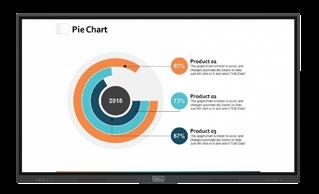
teams to control the office signage from a central location. Smart signage in common areas captures the attention of visitors and employees alike with content-rich office directory signs and digital signage for corporate communications and public outreach. Within the conference room, interactive displays support collaboration between employees that can spark new creative thinking and maximize team productivity.
Effective AV control ultimately unlocks the potential of digital signage, from screens on the wall to transformative tools for enhancing communication and collaboration in any setting.
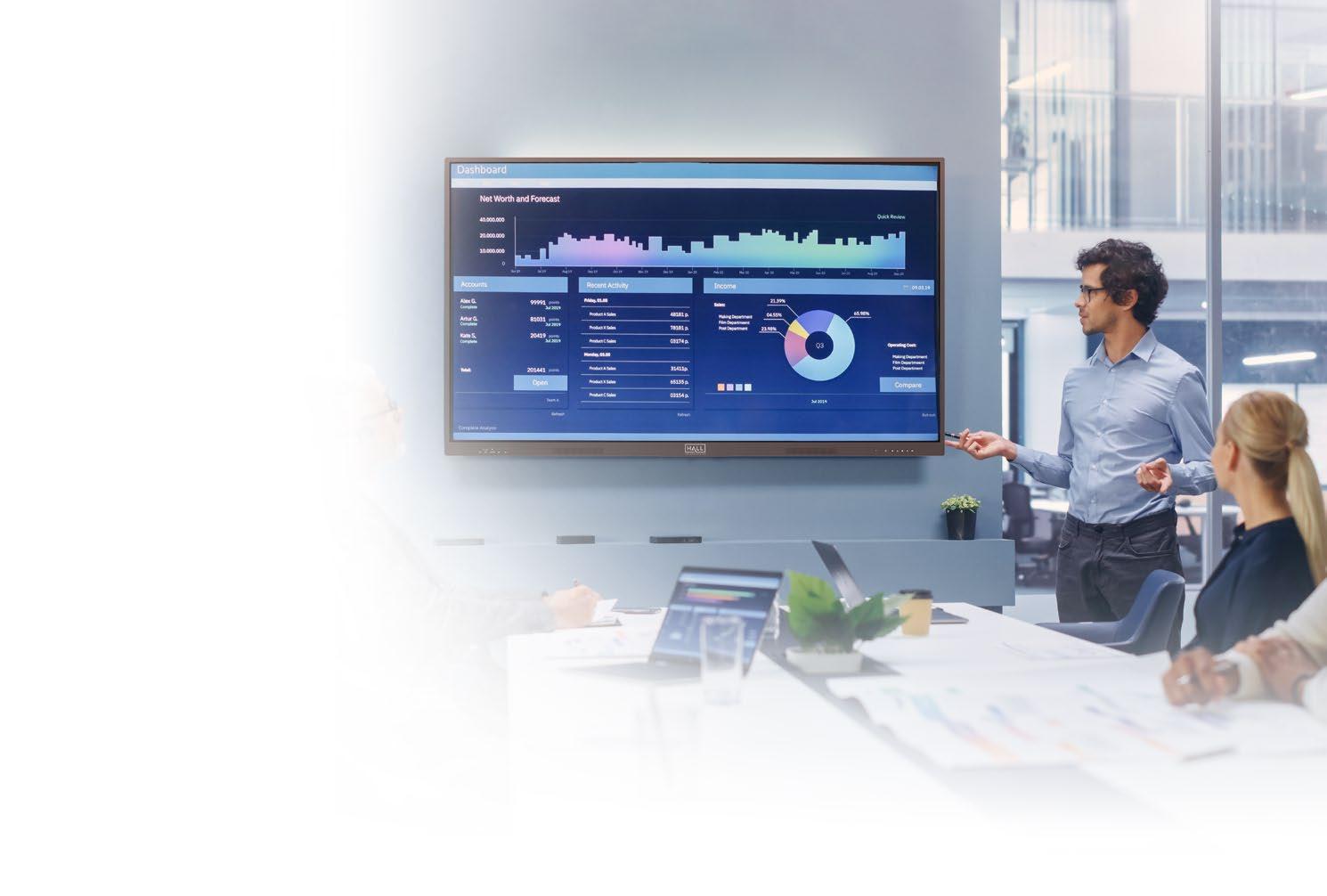
“Effective AV control unlocks the potential of digital signage to enhance communication and collaboration in any setting.”
—Chris Mertens Vice President of US Sales, B2B Displays, Samsung Electronics AmericaVICTORIA GARCIA MASSIMO National Operations Manager

For far too long, HVAC has been the elephant in the room with respect to building automation. In order to meaningfully help a facility operate more sustainably and efficiently, a control solution must address HVAC, which in many large facilities, accounts for up to 40 percent of the overall energy expenditure. Many of the most mission-critical technology devices are also quite temperature sensitive, requiring precise environment monitoring and control for continuous operation and longevity. For sustainability, remote monitoring and management, as well as issue troubleshooting and prevention purposes, it’s extremely useful to integrate HVAC with overall AV system control. However, until recently, doing so meant sacrificing most of the efficiency and precision newer HVAC units, like VRF—which includes inverter, ductless, mini-split, or multi-split units—have to offer.
Traditional single-speed HVAC units cool or heat the space to the set point and then turn off until the space falls outside an established temperature zone, creating a “dead band.” Inverter/VRF units offer more precise and efficient environmental control by constantly operating at a variable rate to more easily maintain a precise temperature set point. However, because HVAC Inverter/VRF system protocols and IoT APIs are incompatible, HVAC inverter systems downgrade to single-speed operation when paired with an IoT device such as a control system or smart thermostat. Thus, the hallmark benefits of inverter/VRF solutions—efficiency, energy savings, and superior climate control performance—are completely lost.
Now, new solutions are entering the market that allow inverter/VRF units to be fully integrated with control systems. This creates a better user experience, to be sure; occupants can control their temperature from the same interface and with the same ease as launching a meeting or controlling the lights. More importantly, however, facility and technology managers can unify the management of HVAC with their other mission-critical systems.

Over the past three years, AV and IT managers have been developing infrastructure to accommodate evolving work and learning paradigms brought on by the pandemic. This sudden shift presented the golden opportunity to implement necessary remote capabilities for collaboration, management, and communication. We now stand at a crossroads, questioning whether these solutions will be fully utilized, validate the investment, or be dismissed as a hasty response resulting in technological redundancy.
AV control is vital in maximizing these solutions. A well-designed control interface significantly boosts system utilization. When integrated systems are user friendly, employees readily adopt them. Conversely, complex or inconsistent systems invite workarounds, risking information fragmentation and security breaches. At 22Miles, we’ve focused on collaborating with premier control system providers to address this need. Our CMS integrates natively with hardware from Crestron and AMX, streamlining complex tasks such as scheduling hybrid meetings. A few taps allow users to find a suitable space, schedule virtual meetings on the organization’s preferred platform, send invitations, and update calendars and room signage globally. This ease of use breaks down barriers and promotes widespread adoption.
Moreover, analytics from integrated control and content management solutions provide invaluable insights into preferred work and learning methods. Technology managers can leverage this data to enhance their existing deployments and make informed future investment decisions, making AV control a critical component in the modern workplace and campus environment.
“New solutions are entering the market that allow inverter/VRF units to be fully integrated with control systems.”
—Victoria Garcia Massimo National Operations Manager Airzone North America
“Analytics from integrated control and content management solutions provide invaluable insights into preferred work and learning methods.”
—Tomer Mann Chief Revenue Officer 22MilesBRANDON WHITE Director of New Product Development Vanco

From an end user perspective, technology should be simple; it’s there to assist workers and learners, helping them to collaborate more effectively and work more efficiently. Steep learning curves and intimidating interfaces, however, often stand in the way of that goal. Modern AV solutions should be friendly, intuitive, and plug-and-play—a lot easier said than done.
From both a product and a solution design perspective, I’m seeing a trend towards prioritizing simplicity for the end user: enabling BYOD, cleaning up the mess of cables and interfaces in favor of wireless connections and USB-C, and automating previously manual functions like camera control or meeting initialization. That user simplicity is often the hard-won result of extraordinary backend complexity. In 2023, one of the control solution’s most important functions is providing visibility into increasingly opaque and un-standardized systems.
The problem with a simple interface is that when something goes wrong, end users have very few options for fixing it. With networkbased remote monitoring and management, technology managers can track and secure all the devices on their networks, BYOD and otherwise. They can also granularly understand the capabilities and traffic on network and USB ports that, to the naked eye, may look identical, but which are actually about as similar as Ethernet and fax. They can troubleshoot, often remotely, issues that the user might otherwise experience as total failure. An enterprise AV control solution is a path behind the curtain, and it is absolutely essential to maintaining the simple experiences today’s end users expect.
BOB WUDECK Senior Director of Business Development

BenQ
AV control has undergone a dramatic transformation. What once required a very expensive controller with limited capabilities is now available as part of an intelligent display or projector ecosystem. This has been fueled by the enormous installation deployments in corporate meeting spaces and classrooms, and the strides made in cloud-based monitoring, management, and digital signage solutions. Whether a video wall, smart board, projector, or digital signage display, it’s reasonable to expect that many rooms—especially meeting rooms and classrooms—have at least one, if not more, displays. This has given rise to the demand for remote on/off control of the display, in order to both save on power costs and prolong the life of the solution. It also enables monitoring and management tasks such as firmware updates that keep displays in peak performance, and enables using those screens in new ways, such as to broadcast alerts, send text or videos, or display digital signage. Rather than pay $5,000 or more for controller hardware and then make separate purchases for display management software and digital signage media players as well as any recurring licensing fees, organizations can expect these capabilities right at the display. This provides benefits that reach far beyond the traditional AV controller, including cost effectiveness. Additionally, all displays can be remotely monitored and managed with the ability to turn them off dynamically—a task not even an expensive wall controller was capable of. Organizations can therefore turn their display assets, now located throughout the building or across a campus, into a much-needed digital signage or alert system.
The AV community has been at the forefront of a technological revolution, designing complex but remarkable AV systems that reshape how we live, work, learn, and collaborate. Without a doubt, it is crucial to have the ability to control and oversee technology systems to ensure smooth operations. As technology becomes increasingly integral, maintaining a strong power foundation around the clock is more critical than ever to guarantee AV projects’ safe and dependable operation.
When specifying AV control systems, integrators must carefully choose appropriate power solutions for each project and effectively manage power quality across multiple sites to achieve top safety, performance, and efficiency standards. Depending on the company’s scale this may require monitoring numerous devices across multiple sites, ranging from tens to thousands of power distribution units, uninterruptible power supplies, diagnostic devices, and more. Then, to ensure control systems work as intended, it is crucial to have access to remote monitoring and control solutions.
The ability to monitor, analyze, reboot, and resolve power remotely allows integrators to assure the performance of AV control systems while minimizing the need for expensive on-site troubleshooting and truck rolls. This solution proves especially useful for managing installations that are difficult to reach, either due to their location or complex design. Today, AV control systems have a remarkable range of features, but integrators and end users must prioritize well-maintained and clean power to ensure smooth operation.

As corporations and educational facilities continue offering a combination of onand off-site attendance, the management of devices that support these options has become more important than in pre-pandemic times. The increase in utilization of meeting rooms or classrooms and lecture halls has translated into an increased number of PTZ cameras, presentation video switches, video matrices, microphones, speakers, video conferencing and audio systems, et cetera. Therefore, the installation of AV control systems has become very popular as they facilitate the operation and management of such AV devices. In addition to the easy operability of the control systems, some may provide a higher level of security, with separate LAN ports to keep the device management isolated from the corporate or school network. This minimizes the risk of hacking or information leakage. Finally, one of the key benefits of a centralized control system is the ability to manage and supervise devices at locations that may be far from where the IT or AV department is located. Therefore, firmware upgrades or device status can be controlled or implemented from a central location without the need to waste time traveling to another facility. Global management platforms have a much farther reach to supervise and control devices in different countries or continents.
JONAS GYALOKAY Co-Founder Airtame
AV control is essential for modern workplaces and campus environments, and continues to grow in importance. Tools that enhance meeting equity and AV control allow for easier communication and collaboration, increased flexibility for organizations and individual users, and the ability to help users better adjust to shifting hybrid work and education patterns.
IT efficiency is a major benefit of AV control, supported through the use of unified solutions that allow IT managers to control a space that houses multiple components and fulfills multiple use cases, also allowing for IT costs to be reduced. AV control makes solutions integration easier to maintain and support when issues arise, and simplifies the onboarding of end users and new tool managers.
End user efficiency and recognition is another benefit created by having a single platform that solves for multiple use cases, making it easier for end users to learn and utilize new technologies. Ease of use and high adoption is key for our new hybrid work and learning reality; organizations have already solidified their at-home meeting strategies, but in-person meetings now need to be just as easy, if not easier. Opting for versatile alternatives leveraging AV control by selecting powerful tools that offer crossplatform compatibility gives organizations the ability to effectively maintain agility and adaptability amidst the continuous evolution of collaborative technologies.
AV control is a powerful tool for both installers and end-users, allowing for not only flexibility in hybrid work and campus environments, but ease of use and adoption across all fronts as well. Hybrid collaboration is only as seamless as the tools used to execute it, and ensuring organizations have a reliable and straightforward solution is key in ensuring AV control systems reach their maximum potential. A strong AV control system that supports BYOD meetings is invaluable, as hybrid spaces continue to evolve and are certainly here to stay.
“Firmware upgrades or device status can be controlled or implemented from a central location without the need to waste time traveling to another facility.”
—Christian Young Pro AV Product Manager ATEN Technology
“A strong AV control system that supports BYOD meetings is invaluable, as hybrid spaces continue to evolve and are certainly here to stay.”
—Jonas Gyalokay, Co-Founder AirtameBILL HENSLEY Head of Global Marketing RTI
Even way back in the days of the classroom film strip or the slide show in the boardroom, there was generally a reliance on the school or office tech to make it happen. My first job out of university was as an advertising agency account executive, and on one save-thebusiness presentation to the client’s board I hit the wrong button on the slide carousel, cycling through most of the presentation before we could stop it—much to the enjoyment of the board, but not so much of my boss. Where was that tech manager when we needed them? We didn’t retain the account.
In this modern day, when everything is connected, we need tech specialists more than ever, but with everyone watching budgets they may not always be available. In steps AV control technology. The real opportunity is not to think of it as just AV control, but meeting room control, boardroom control, lecture hall control, classroom control, et cetera— that is, control of everything from lighting to climate, shades, and room scheduling, plus the different aspects of AV control.
It’s an easy assumption when we think of it from the user’s perspective. After all, professors don’t want to learn multiple systems every time they enter the lecture hall or meeting room. They want to hit the “start lecture” button and have everything turn on/ off or open/close accordingly. And likewise for the team meeting in the conference room or huddle space. It’s also not just AV; lighting and shades are part of almost every meeting space.
The size of the deployment impacts the solution, but we are seeing lots of repurposing of spaces. Perhaps a new wing of classrooms on campus or a new hall of huddle spaces for occasionally-in-the-office collaborators present an opportunity not to redo everything, but to try something new.

When AV control is integrated with softwarebased platforms like Utelogy, it enables estate managers to transition from a reactive to a proactive strategy. In the current landscape of enterprise and campus settings, the most crucial facets and advantages of AV control come to light in terms of realizing environmental sustainability and orchestrating AV/IT support resources with optimal efficiency.
Drawing a distinction between the in-room control features provided by many major vendors and the control capabilities within the Utelogy platform is vital. Standard in-room control panels typically offer the capacity to initiate or terminate calls, adjust volume or cameras, et cetera. Utelogy indeed provides these functionalities, but its edge lies in its software-based control which enhances those in-room solutions by focusing on back-end device management, monitoring, and data collection. The power of Utelogy’s platform is specifically unleashed through automated system management and self-healing capabilities.
Utelogy’s automated control capabilities can extend to overnight room testing, conducting audio and video test calls, maintaining the volume levels in a room, injecting pink noise in a room to ensure the speakers are working properly, checking device health, powering everything on, making sure a system is connected, healthy and working, rebooting a system if required, and then powering everything off. This is closely connected to an organization’s sustainability efforts by maximizing energy savings until a room is ready for its next use.
A very common self-healing event may occur if a display with HDMI-1 as its default input is mistakenly switched to HDMI-2. The platform is immediately alerted that a change has been made to the programmed settings, and the Utelogy software will automatically switch the input to the correct setting, with no human intervention necessary.
In addition to enhancing sustainability, this level of automation eases the burden on estate managers, who are increasingly tasked to do more with fewer resources and tighter budgets.

“Professors want to hit the “start lecture” button and have everything turn on/off or open/ close accordingly.”
—Bill Hensley Head of Global Marketing RTI
“The advantages of AV control are realizing environmental sustainability and orchestrating AV/IT support resources with optimal efficiency.”
—Nicole Corbin Vice President Business Operations Utelogy

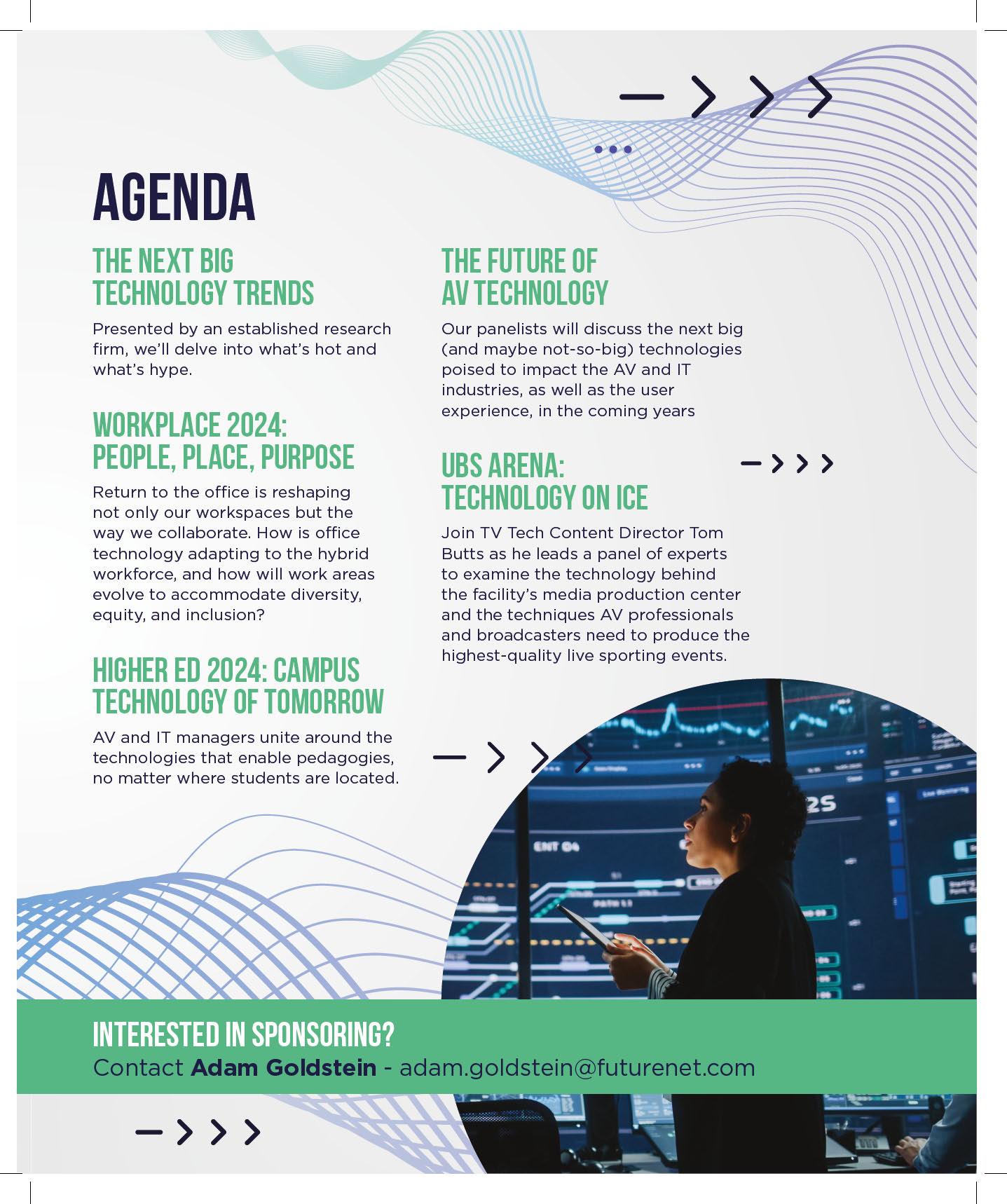
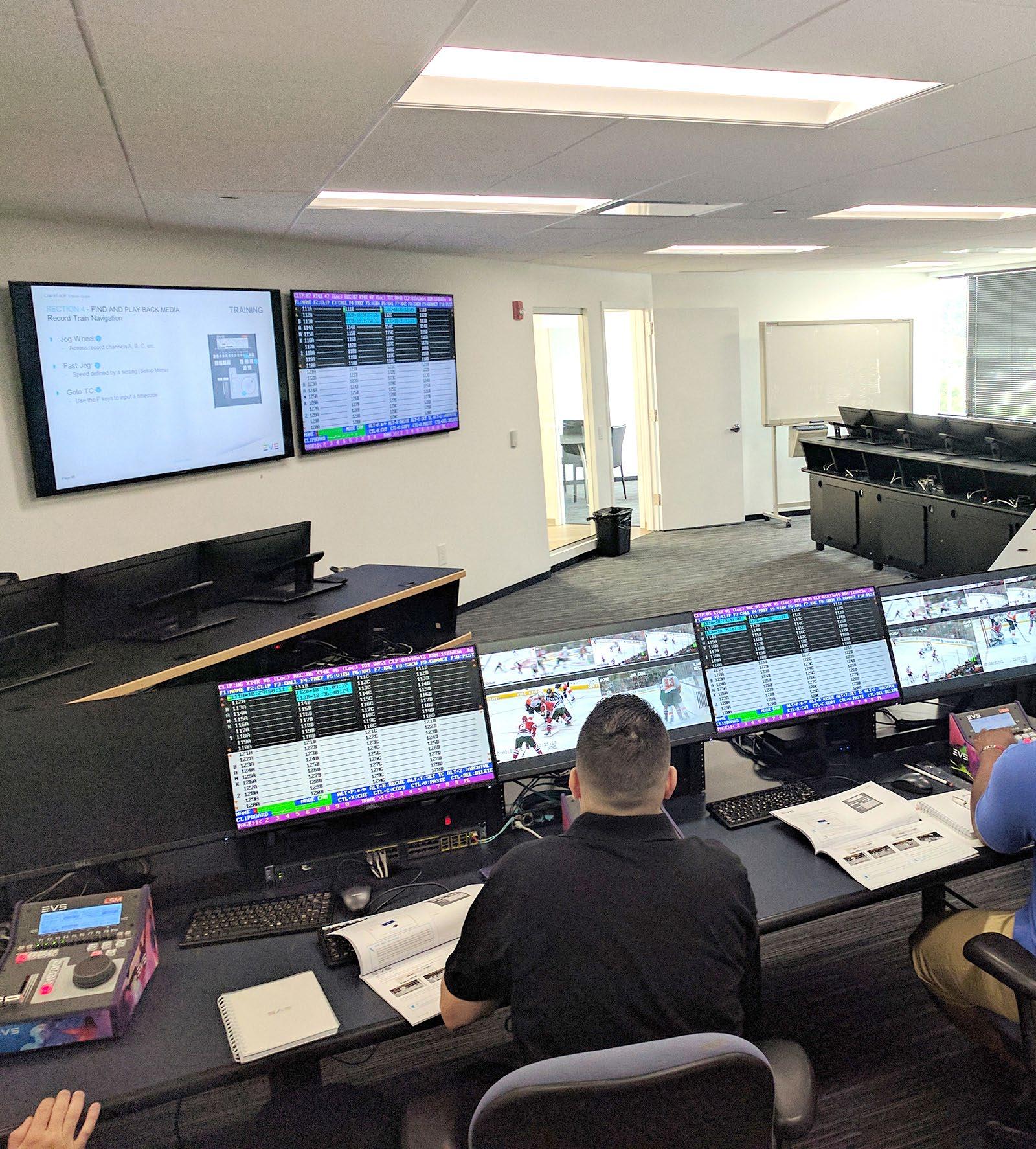
EVS is globally recognized as the technology leader for video production, with wide-ranging HD-to-UHD/4K solutions for live sports, entertainment, and news content. You’ll find EVS’ premium media technologies in operations throughout the world, helping broadcasters, rights owners, and producers optimize live assets, engage audiences, and increase revenue streams by monetizing content across multiple platforms.
Customer research and education are critical to what EVS does. With training facilities in 12 locations around the world, it’s a way for them not only to introduce new products and offer in-depth, hands-on training, but to understand what customers need and how they use EVS’ products.
The crux of the new training center is the main instruction room with 10 seats—nine for the trainees and one for the trainer. There are two monitors per trainee plus two for the trainer, for a total of 20, in addition to two 70-inch monitors on the wall for all to see.
Besides using KVM (keyboard, video and mouse) for all seats in the training room, KVM also controls stations in the VIP room, a more comfortable, lounge-like room used for dedicated behind-the-curtains demos and proofs of concept with VIP clients. Two of the training room seats also feed the main conference room, making it possible for meeting participants to call up information from the training room during a meeting, if necessary. There are two more seats in the reception area to greet customers with EVS’ newest product, X-One, a touchscreen-enabled product that allows customers to walk up, touch it, play with it, and see features before getting into their in-depth training.
All screens are touch-screen-enabled, and every seat— monitors, keyboard, mouse, and touch screens—is accessible by KVM.

EVS’ KVM use case is different than in a traditional broadcast environment, where operators call up a product and use it to send something from point A to point B. Because they are training, they must be able to present and push the trainers’ screens to the operators and vice versa. They also need to preconfigure and save training sessions so they can be called up at will. And given the multi-room setup, they needed a quick, robust KVM switching capability to pass seat control from room to room at a significant distance within the building.
One major advantage IHSE KVM offers EVS over their old training facility is that trainers can now push their screens to the trainees, so trainees can see the lessons up close. Then, with a keyboard stroke, trainees can quickly switch back to their local machines to practice the functions in the lesson. By the same token, trainees can push their own screens to the large monitors in the front of the room, which come in handy when a trainee does something noteworthy that would benefit the rest of the class. Also, as long as the screens are next to each other, IHSE KVM enables one keyboard and mouse to span multiple screens and control multiple PCs.
The second advantage is that now multiple classes can be pre built using IHSE’s Draco tera tool software, which offers the flexibility to go from one training session to another with the push of a button. EVS uses the tera tool to build screen layouts and lessons for their many products, and then they simply take a few minutes to load the appropriate lesson before the class starts. This is a major improvement over the old way, which required a support engineer and a day’s worth of time to reconfigure the training lab for each new class.
The KVM specs for the training center include: an IHSE Draco tera Compact Matrix, 80-port, Cat-X; 53 CPU sources with a mix of EVS XT, Epsio, XF3, and IPDirector units, with CPU units based on DVI with RS-422 to support XT servers and serial control for LSM remote control panels; 11 CON workstations with a mix of touch-screen capabilities, based on HDMI with RS-422 to connect to LSM remote control panels; and some workstations use HDMI CON with local input to share between remote XT and local XT servers at the same workstation.
With IHSE KVM gear, the necessary flexibility, configurability, and robust switching are in place to make the new training center shine. Thanks to a history of success with IHSE, and especially owing to the success with the US headquarters training center, EVS is looking to add IHSE KVM gear as they expand regional training centers.”
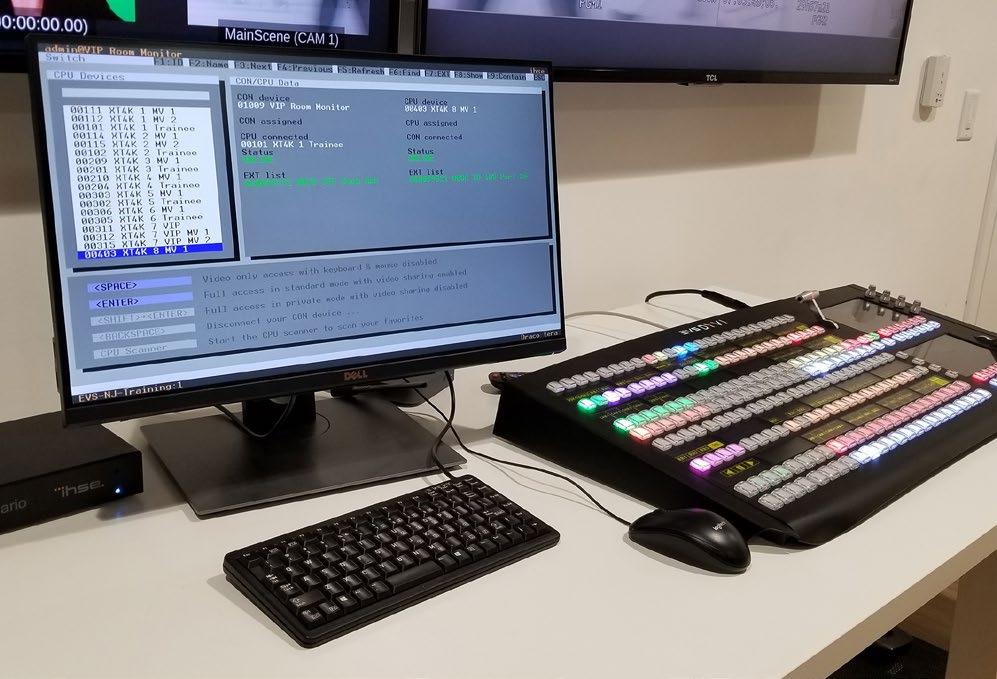
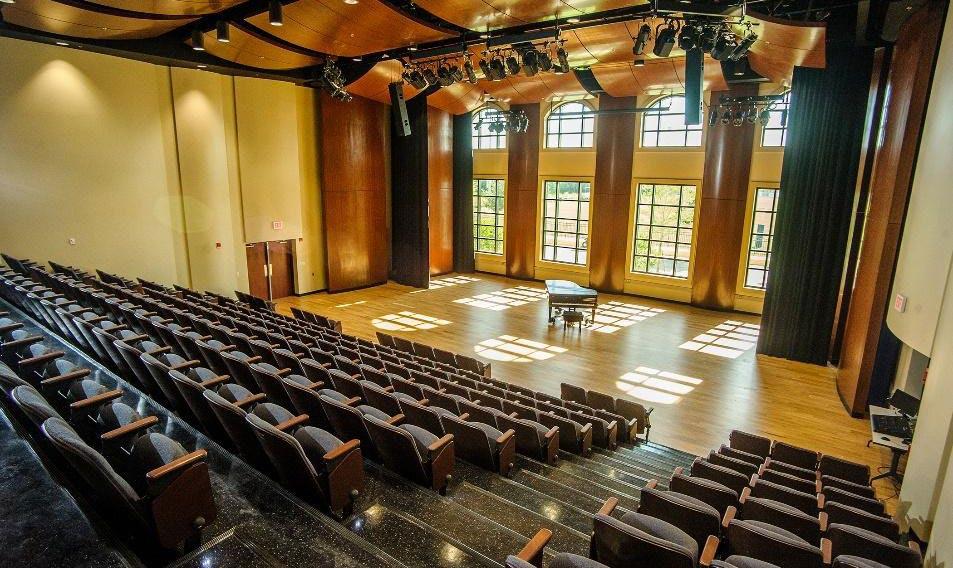
Berkeley Preparatory School, a highly ranked pre-K to grade 12 day school in Tampa, has a jam-packed schedule of activities—all of which require wireless audio solutions—for its 1,400plus students. The state-of-the-art school has long used Sennheiser G3 wireless for its audio needs, but recently, productions technical director Christopher Cook had been looking for a new solution to meet RF challenges while enabling a fully networked solution across the sprawling campus. With support from Beamworks, Inc., Berkeley Prep rolled out 40 channels of Sennheiser’s EW-DX wireless system, the newest and most robust offering from the Evolution Wireless Digital family of products.
Given the nature of Cook’s role, he does not have room for equipment failure or troubleshooting, and must always be prepared for the unexpected. “If something goes down, I need a fast repair,” he said. A longstanding Sennheiser user—Cook was reliant on the quality of the G3 wireless system for many years, and now subsequently the EW-DX. He said, “Luckily, things don’t go wrong often with Sennheiser.”
As an AV team of one, Cook needed a fully networked solution that could be managed offsite. He explained, “Our campus is 80 acres, so I’m not able to walk from room to room; I have to hop on the golf cart. Now I just go
on the computer, pop on Control Cockpit, and make sure everything is good. We are networking all audio consoles.” Sennheiser EW-DX’s can be managed via Control Cockpit so Cook can oversee, coordinate, and troubleshoot wireless operations from his laptop. As Berkeley Prep’s wireless setup spans three black box theaters across the elementary, middle, and upper school divisions; a main stage 820 seat theater; a recital space; and a brand-new chapel, being able to manage all of these spaces and more from a centralized hub was a key consideration in their wireless audio decision.
Cook worked closely with Berkeley Prep’s trusted partners at Beamworks to plan, purchase, and roll out the EW-DX system across campus. Drew McMullian, operations manager at Beamworks said, “Getting everything connected and networked has been incredible. They built a beautiful new chapel recently, and the AV room is up a spiral staircase, so it is not accessible if you need to get there quickly.” He continued, “Being able to control the wireless from the Control Cockpit software is a necessity for Cook. All of this, with the flexibility to use any Neumann or Sennheiser capsules to outfit the church choir, made this a spot-on setup for Berkeley Prep.”
With so many daily activities across campus that require wireless audio both indoors and
out, navigating air traffic and buzzy Downtown Tampa to dodge dropouts and interference can feel like an obstacle course. Berkeley Prep needed a wireless system that could handle the crowded RF spectrum while minimizing the legwork. EW-DX offers the lowest latency on the market (1.9ms) and eliminates the need for frequency calculation thanks to its equidistant frequency spacing which does not pollute available spectrum with intermodulation.
The recent installation of EW-DX across Berkeley Prep’s campus was completed at a crucial make-or-break-it point. The rollout was right in time for technical week, or tech week, for the school’s highly anticipated production of Mean Girls. They were the first school in Tampa to adapt the popular musical, and the wireless system rose to the challenge, “I used 24 channels of EW-DX, and it was immediately night and day [from our previous system]. The sound quality was more natural, the intelligibility was better—they were just so clean,” said Cook. “I didn’t change my mic technique; it was just the units. I got a lot of great comments about how natural the production sounds.”
Cook sees that the future is bright for EWDX on campus, with opportunities to improve audio in more places: “I’m really excited to eventually merge out into the athletic fields. For now, whenever someone sings the national anthem, we bring out the EW-DX. Eventually I want each venue to have EWDX managed through Control Cockpit. I look forward to expanding with the EW-DX line and growing with it.”
Beyond the sound quality, ease of use and centrally networked setup, the EW-DX upgrade at Berkeley Prep has given Cook a distinct return on investment that most education industry AV and IT professionals could benefit from. He explained, “Anything that takes away stress or provides you with more time back in your workday is huge. All we have as people is our time, so anything to give you more of it is worth the investment.”
With recent funding programs intended to help schools invest in new technologies, the Warren County Public Schools district in Kentucky recognized that it could help teachers simplify tech-based classwork and increase student engagement using the breakthrough Airtame platform for shared screens. According to WCPS instructional technology coordinator Matt Kresslein, the Airtame platform, enabled by the Airtame 2 hardware, is now providing seamless wireless screen sharing and district-wide digital signage opportunities across approximately 1,200 TVs in the district’s 28 schools and seven non-instructional facilities.
“We’re always looking for sustainable solutions that provide consistency in our instructional spaces, and Airtame, in conjunction with TV displays and devices for each student and teacher, provide that consistent experience,” Kresslein said. “We have transitioned from interactive whiteboards located at the front of each room to TVs with the Airtame platform, which has freed our teachers to move around the room as they lead digital lessons delivered wirelessly from mobile devices.”
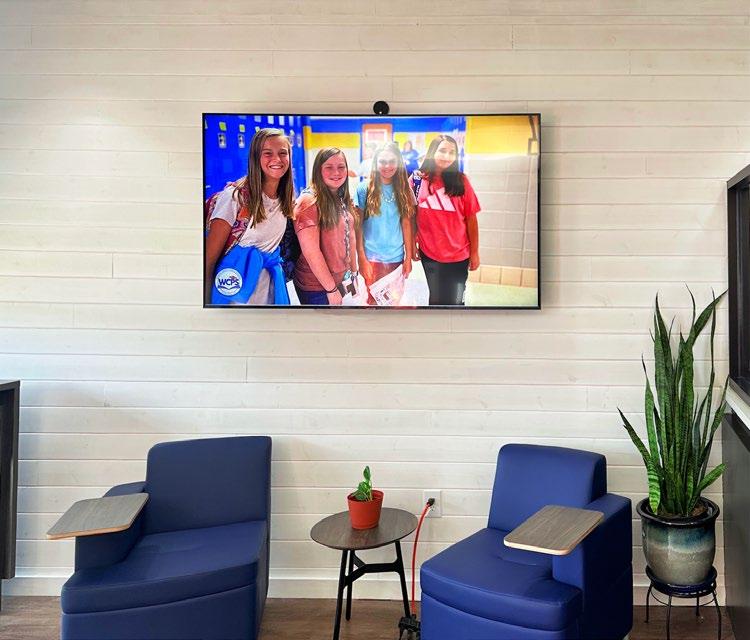
With every room featuring the same technology design, teachers can now walk into any classroom and instantly connect their laptop or mobile device to the display and begin screen sharing. Teachers can even designate a “Favorite Airtame” that keeps the chosen Airtame and TV at the top of their connections list so there are no complications or barriers to presenting wirelessly. It’s a secure procedure that ensures schools can be as flexible as required while delivering consistent quality.
One of the major advantages of using Airtame is that the platform protects and prioritizes teachers’ wireless connections, strengthening their control of the classroom. The prior whiteboard solution allowed any wireless device to override teachers’ connections, which presented an opportunity for students to interrupt lessons and disrupt class.
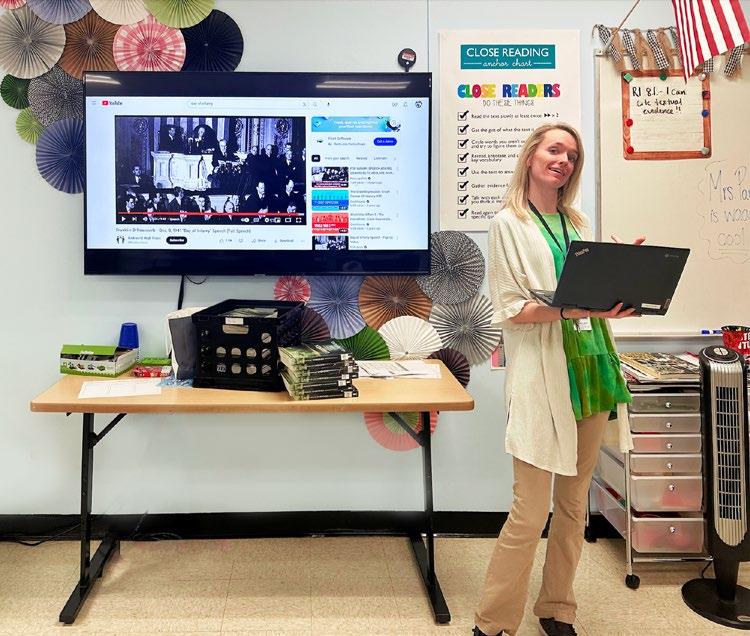
“Users love Airtame because of its ease of use, flexibility to support different apps and devices, and its robust digital signage capabilities that enable centralized management,” said Simon Hangaard Hansen, Airtame vice president of Product. “When we talk about an entire school
district, the effects cannot be overstated.”
Unlike the independently operated whiteboards, the Airtame platform allows administrators at the school or district level to treat every TV as an endpoint in a consolidated digital signage network. They can present messages, announcements, notes of recognition, and other info to specific classrooms or schools, or across the entire district. Beyond the classroom, this has enabled the school to easily deploy digital menu boards for cafeterias, among other usage scenarios.
“Airtame has empowered us to share districtwide signage and videos, such as the studentcreated projects we displayed during Digital Citizenship Week to celebrate students’ digital agility and safety,” Kresslein said. “Student access to wireless sharing is decided at the school level, and Airtame’s device-agnostic experience makes connecting as easy as possible, whether users connect from our Chromebooks or a smaller number of iPads, MacBooks, and PCs deployed in various locations. Finally, having centralized control of all the devices’ settings allows us to quickly perform software updates and identify any issues to initiate IT work tickets without bothering the teacher.”
It was important for the school’s new technology solution to support all existing functions, including annotation apps teachers currently use on their Chromebooks. Since Airtame wirelessly mirrors the user’s entire screen and doesn’t require using a specific app or device, teachers can use content from a wide variety of sources without changing any settings or remembering any specific procedures. The new system also eliminates the need for teachers to sign in. Airtame’s ability to schedule the on/off times for all 1,200 TVs also ensures maximum power savings and screen lifespan, while also taking one item off the teachers’ list of responsibilities.
After extensive testing and evaluation, Warren County Public Schools entered into a five-year licensing agreement to ensure reliable and repeatable learning environments and instructional processes. The district may find even more uses for the technology in the future, as Airtame regularly issues software updates and new features to enhance the classroom experience.
The University of Manchester Engineering Campus Development (MECD) in England provides expansive research, learning, and meeting spaces for more than 8,000 engineering and science students.
Recently, the university required flexible AV switching systems with robust sound and intuitive control for hundreds of flexible teaching and learning spaces. All rooms in the MECD needed to be linked together, and the AV systems would also need to integrate with the university’s resource management system, Extron’s GlobalViewer Enterprise (GVE).
Pure Audio Visual Ltd. (Pure AV) worked closely with the university IT/AV team to design the AV systems. Then, they spearheaded integration of the full selection of products from Extron, including professional-grade AV matrix switchers, switchers, DSP audio and control systems, and a NAV Pro AV-over-IP system. The project added approximately 2,200 learning, meeting, and social spaces over a combined floor area of 861,113 square feet (80,000 square meters).
When deciding on the best space for a particular lesson, instructors can look up rooms by size and AV capabilities on the Room Catalog website. It includes photographs of each room and any space configuration options, as well as details about the provided and auxiliary AV equipment and connectivity capabilities by room.
Large meet and teach rooms include a Panasonic 10,000-lumen projector and a Sapphire screen, one or more Kaptivo Capture Boards, interactive whiteboards, and LG video walls. Panasonic displays on walls and carts augment visibility in the medium and large spaces, with the portable displays connected over HDMI. Room sources can incorporate combinations of one or more computers, a document camera, PTZ and network cameras, multiple microphones, and AV connectivity for wired and wireless devices. These and the mid-sized rooms provide an XTP system or a fixedconfiguration AV switching system from Extron, with a rightsized switcher or matrix switcher, depending on room size and available resources. The in-room sound systems are based on Extron ProDSP processors such as the DMP 128 Plus audio processor with AEC, VoIP, and Dante to manage mixing of program audio and microphone feeds.
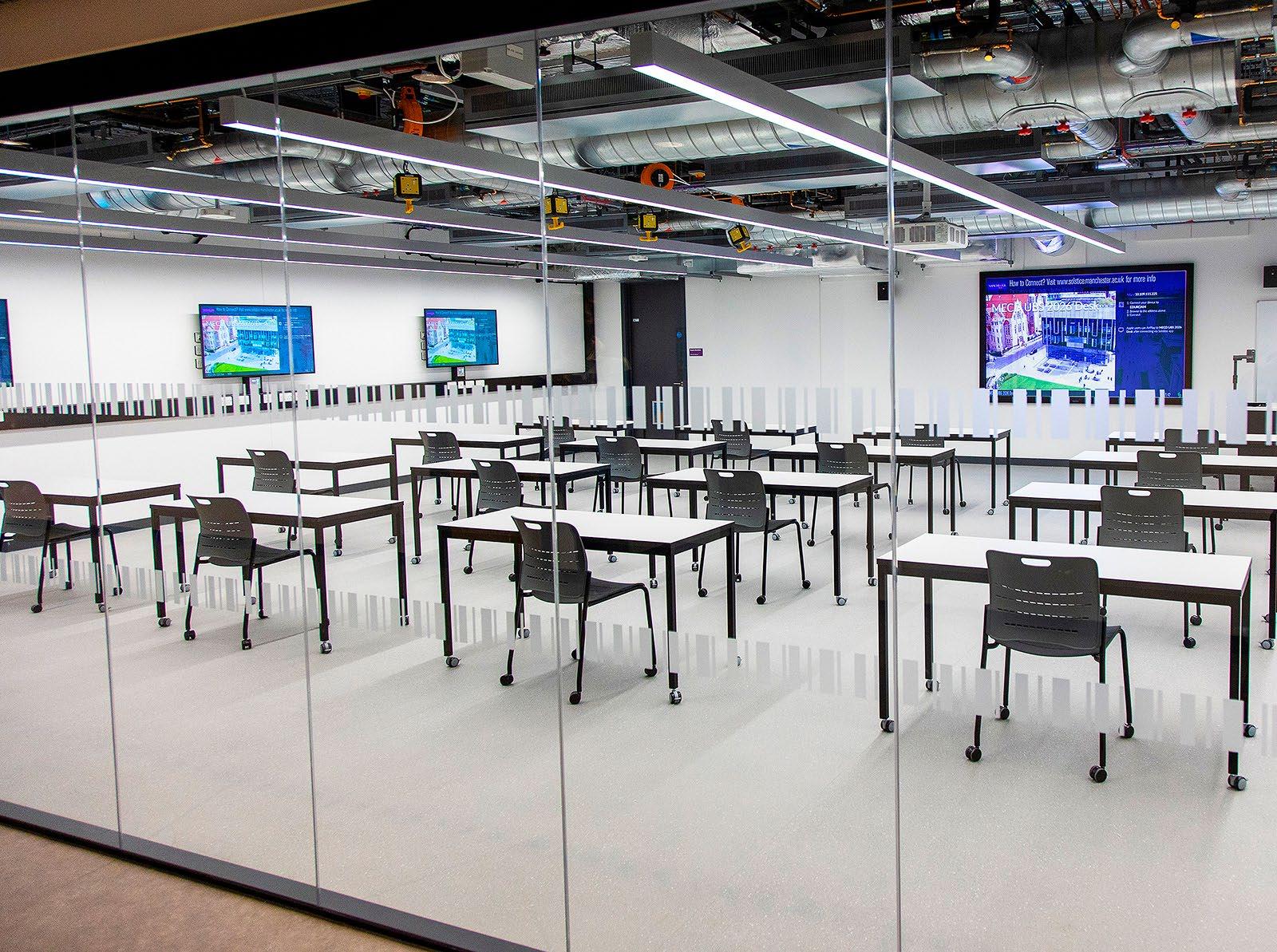
For AV system control, each room is outfitted with an Extron IP Link Pro control processor that works in conjunction with NBP 106 D Network Button Panels and TouchLink Pro touchpanels to provide intuitive control for all system functions.
To link each MECD room to the rest of the spaces on campus, Pure AV integrated an Extron NAV Pro AV-over-IP system. The system includes 186 endpoints, enabling content to be shared among any number of destinations. This is true even when one or more of the divisible spaces are reconfigured. Trevor Byrne, head of Media Services at the University of Manchester said, “We can send a source from any room to any other room in the
complex; the NAV system turns the entire MECD complex into one enormous, flexible learning space.”
The NAVigator System Manager enabled quick, intuitive configuration and control of the NAV encoders and scaling decoders over the MECD data network. It integrated with GVE, tying together the campus spaces. GVE and the NAV Pro AVoIP system combined to provide a secure platform that enables device connectivity, status, and control from the intuitive web pages within this resource management software. Also, alerts were set up within GVE to notify the support team of device connection status changes.
The Extron AV switching, distribution, and control systems— linked by the NAV Pro AVoIP system—offered the flexibility, performance, and scalability that the university required for reliable delivery to and from each connected room on campus. Designed in partnership between Pure AV and the university’s technical and academic teams, MECD continues to meet and even exceed student, staff, and administrative expectations.
“MECD affords an exciting new environment for the delivery of interdisciplinary research, teaching, and impact across engineering,” said Professor Martin Schröder, vice president and dean of the Faculty of Science and Engineering at the University of Manchester. “We have created an inspiring, highly flexible first-class teaching and research environment that transforms the way in which the University educates engineers and material scientists for the future.”
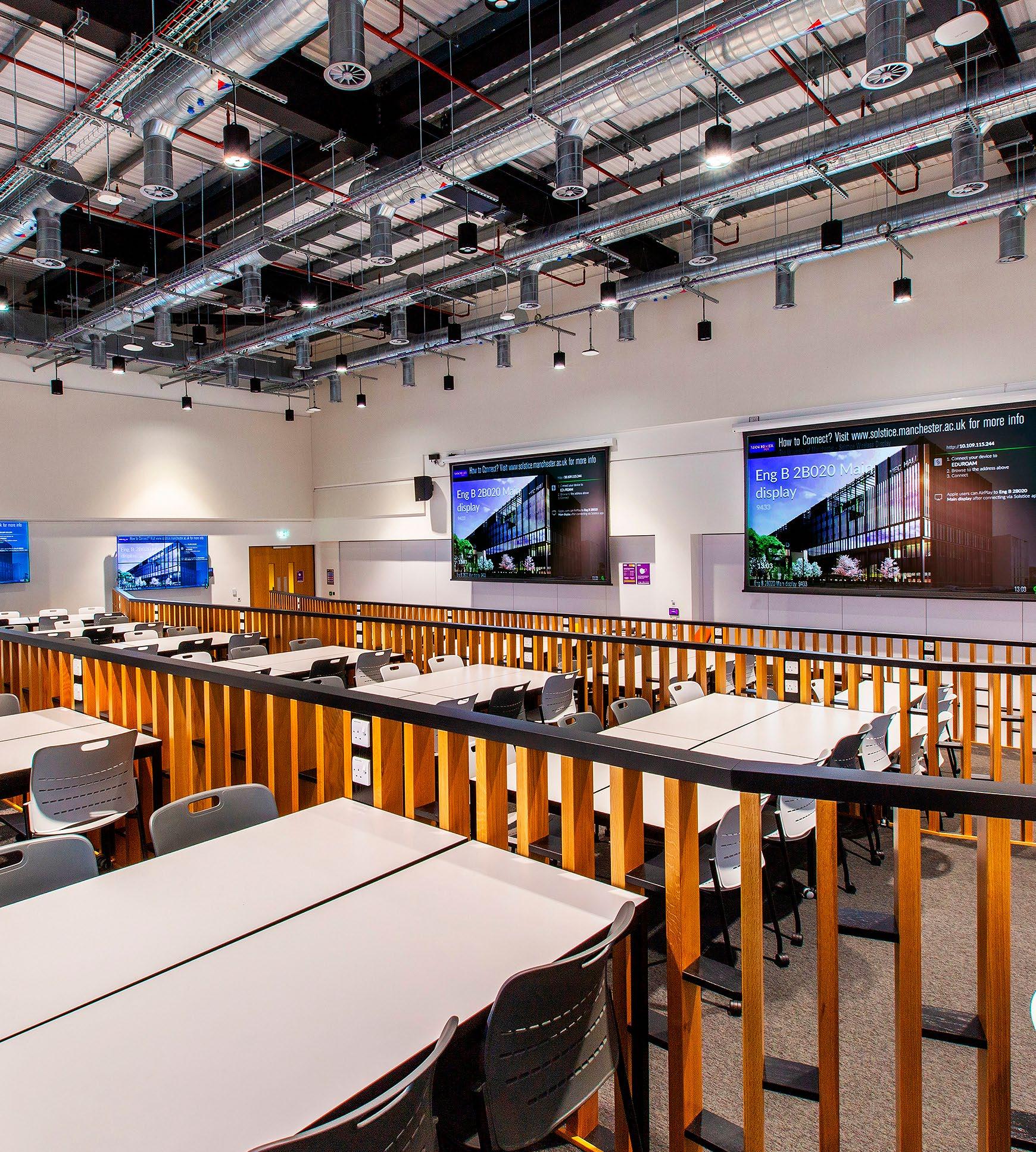

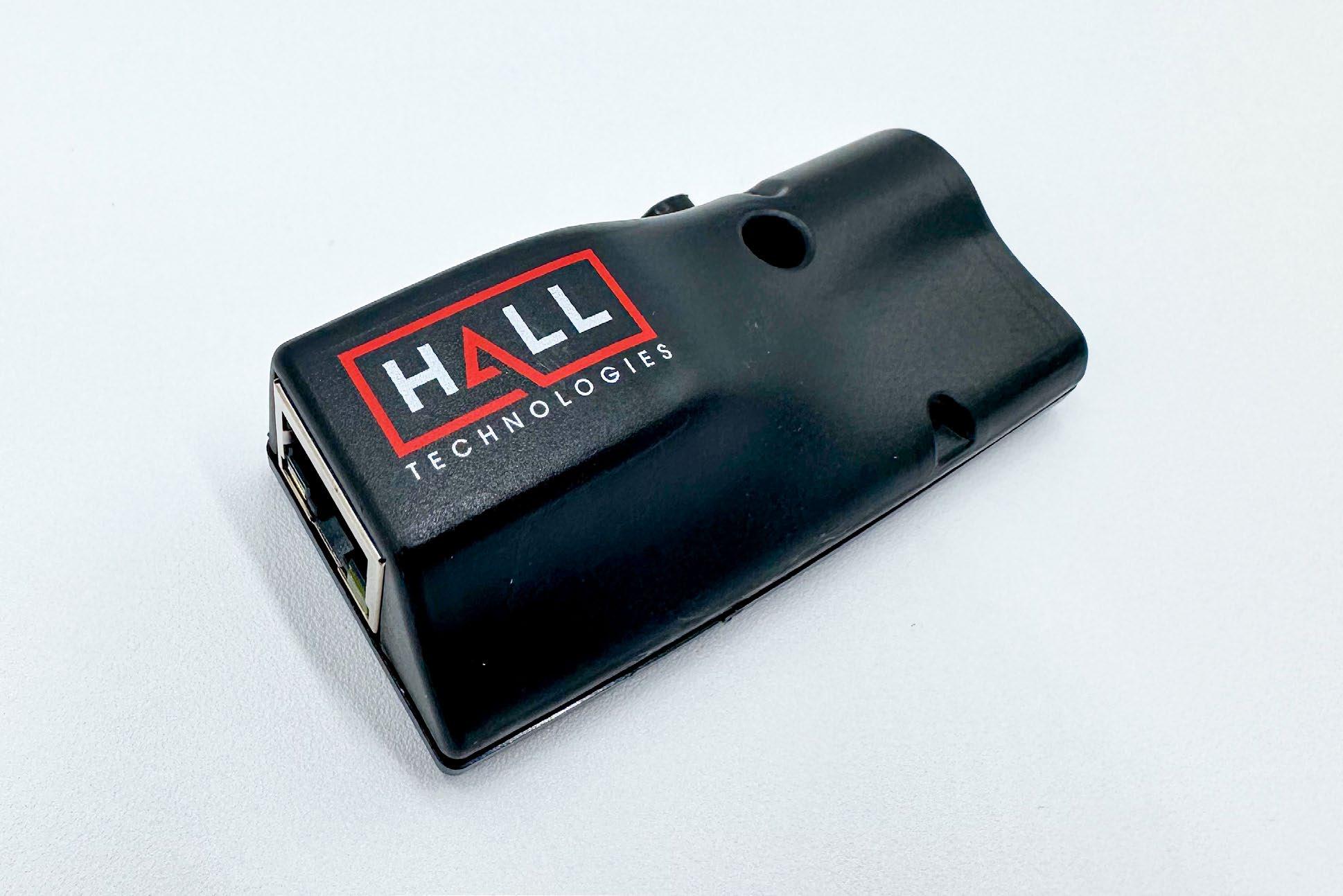
Hall Technologies’ Hive Node Kits are advanced IoT controllers that offer an efficient and compact solution for controlling devices through RS-232, IR, and relay interfaces via IP. These PoE-powered kits are designed specifically to enhance the capabilities of the Hive Touch control panel and the Hive KP8 control keypad. HIVE Node Kits offer a built-in IR Learner with a robust database for effective control; a web interface for easy set up; and is equipped with IR, RS-232, and relay accessories for diverse control.
halltechav.com
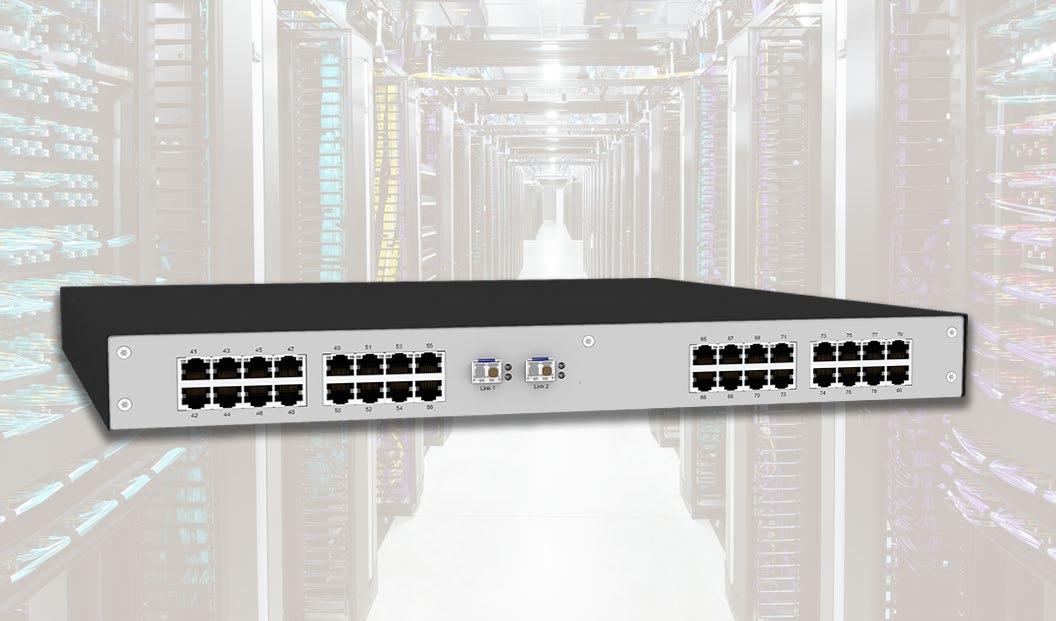
IHSE Draco G-Flex KVM Matrix Series, with an integrated Draco tera IP gateway card, provides systems designers with the ability to bridge multiple KVM matrix systems over an existing IP network. It combines the high levels of security and performance of the Draco tera KVM system with the flexibility and ease of connectivity inherent in IP-based communication. The Draco G-Flex matrix starts with 16 physical ports and eight gateway ports and can be expanded up to 152 physical ports and eight gateway ports in four RUs. Systems can support hybrid fiber/copper cabling requirements.
ihse.com
Yealink’s MeetingBoard is a collaboration display that delivers an incomparable video conferencing experience suitable for all scenarios.
MeetingBoard features six speakers, a dual-camera system, a 4K touch display, and a 16-MEMS microphone array. It enables AI-powered features such as auto framing, speaker tracking, multi-focus framing, noise cancellation, and reverberation suppression. In addition, it allows seamless collaboration with Microsoft and Zoom’s native whiteboard. The touch panel CTP18 makes meeting control easy and intuitive. The presentation pod WPP30 provides a plug-and-share experience. The additional 6x and 12x optical PTZ camera and extended wireless microphone VCM36 expand the room size, and the RoomPanel and RoomSensor make MeetingBoard part of an intelligent meeting system.
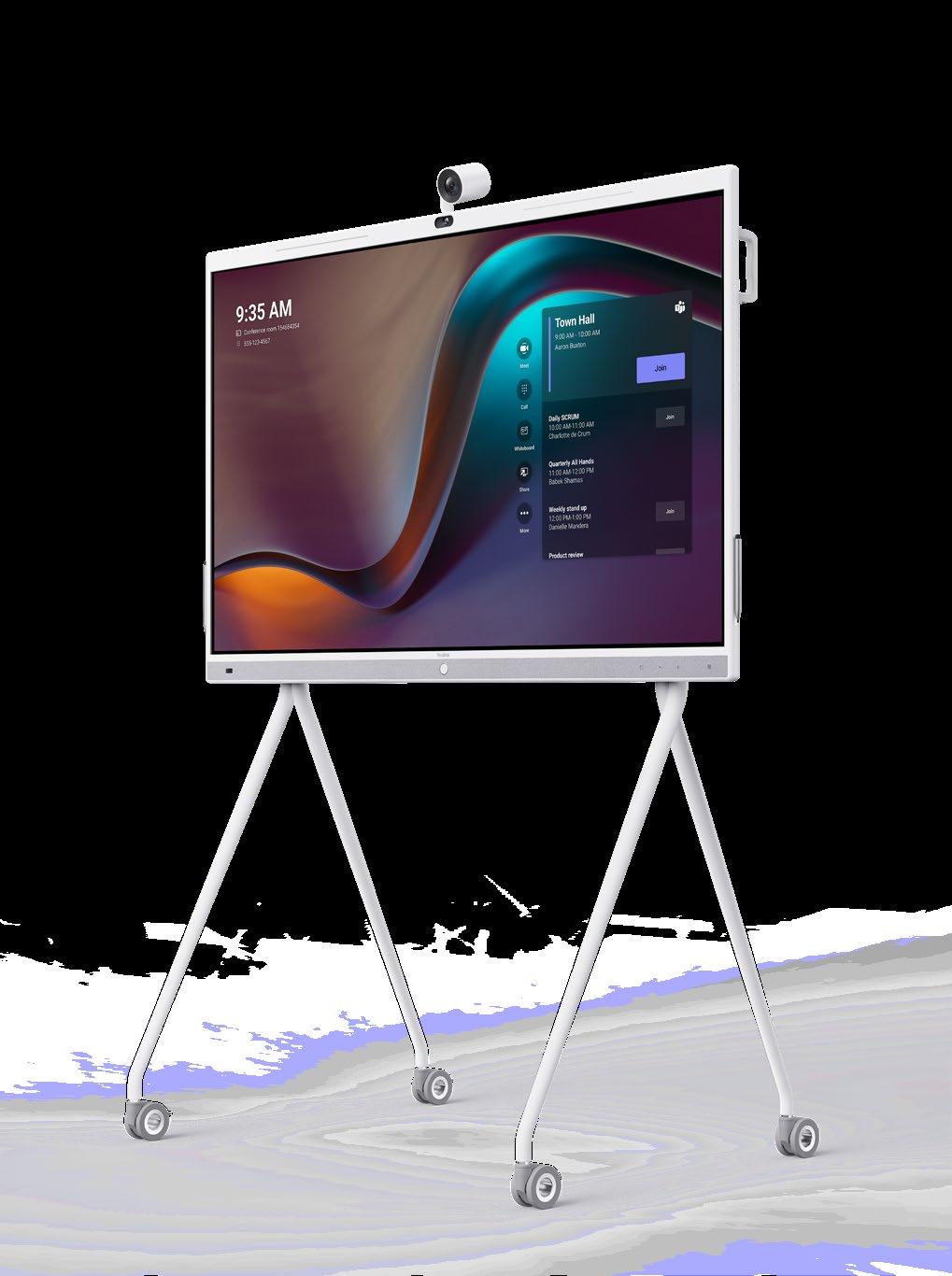
Atlona’s Velocity Premier Services Remote Gateway (AT-VPS-RG), showcased at InfoComm, is available in three annually renewable tiers to match the processing and data requirements of specific Atlona Velocity hardware and software gateways. The service streamlines tasks including system setup, device configuration, and troubleshooting as well as credential and firmware updates from any device with an internet connection. Using cloud technology, VPS-RG establishes a secure proxy connection between a server and the gateway over the internet. This allows customers to remotely configure systems and manage devices without having to directly access the corporate network, simplifying the entire rights and permissions process.
atlona.com
Yamaha UC’s ProVisionaire is a suite of software applications for the design, operation, and management of sound systems built around Yamaha audio products. Equally suitable for both the entertainment and AV markets, our fully customizable ProVisionaire software lets you create complex, fully scalable audio systems using just one software suite— no matter the size. It can be operated by anyone—no matter their experience level—using a tablet, laptop, or desktop computer.
usa.yamaha.com
Sennheiser’s Control Cockpit is the central software for easy handling, control, and maintenance of the entire SpeechLine Digital Wireless system, as well as many of the TeamConnect family of products and the EW-DX wireless system. The easy-to-use interface provides a dashboard overview and control of an entire campus-wide device setup at all times. It shows all status information at a glance, including remote access to all device settings and workflows, making setting adjustments for one or multiple devices at the same time very easy.
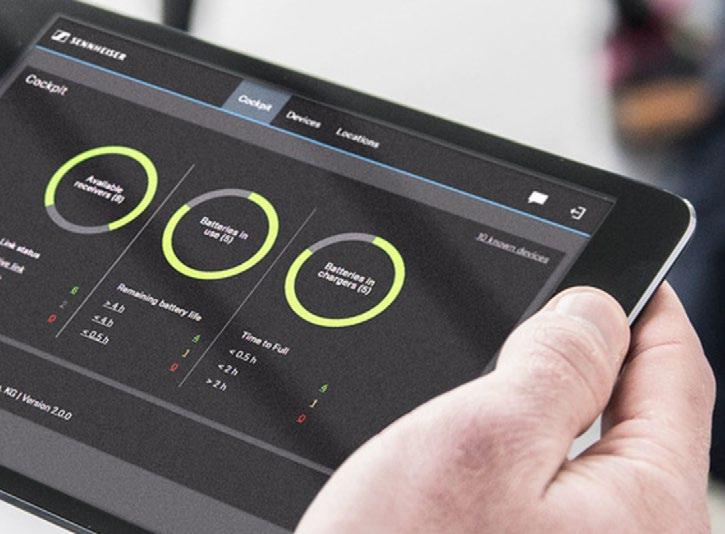
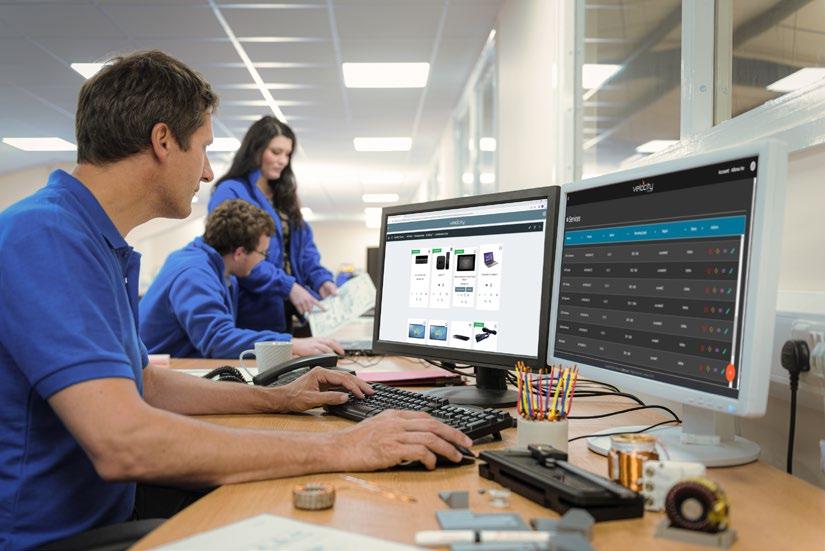
en-us.sennheiser.com
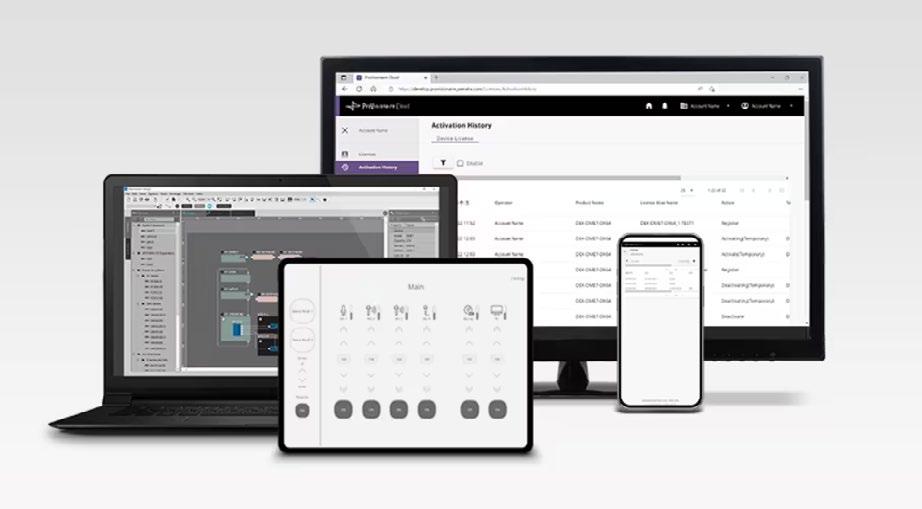
Legrand C2G’s C2G50348 AV Controller is a versatile device designed to control third-party devices with ease. It features programmable buttons that can send bidirectional RS232 and RS485 commands simultaneously, as well as infrared codes and relay control commands. Each button incorporates an infrared and RS232 code learning function, along with baud-rate setting capabilities. With the option for daisy chaining, up to 99 programmable control panels can be linked and controlled together using ID identification. The controller is programmable via USB using the AV Controller software. With dimensions of 11.4cm by 7cm, it offers a compact, userfriendly control solution.
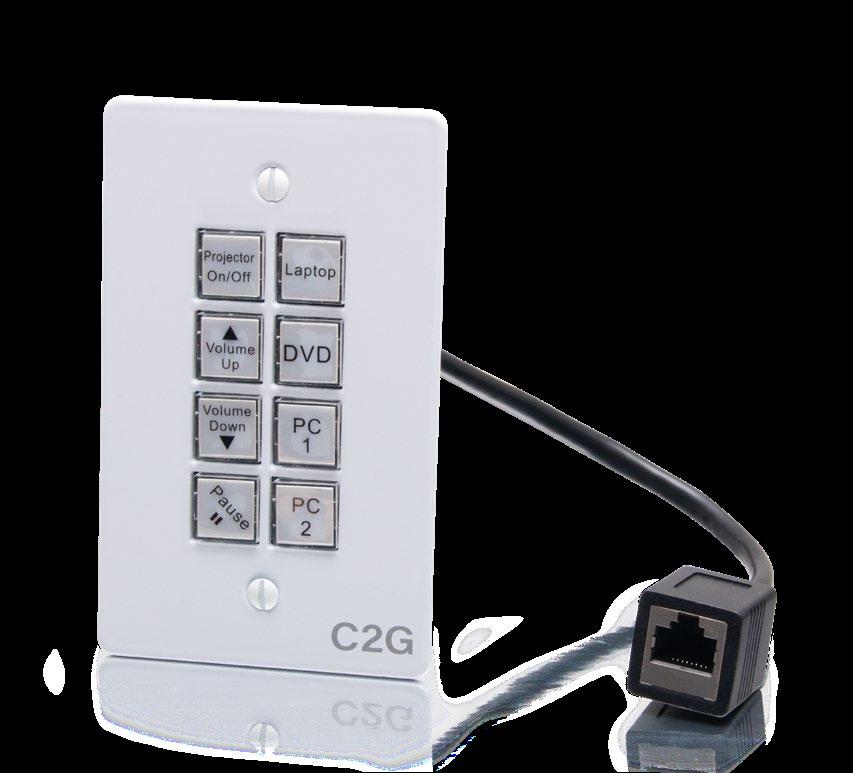
cablestogo.com
8
9 MagicINFO
Samsung’s MagicINFO is an all-in-one content and device management platform that connects all displays remotely from any location. The MagicINFO operating system allows users to remotely create and deploy captivating content and flexibly manage and secure hardware and software at scale. Updating your educational digital signage ecosystem is instantaneous to showcase content such as food menu items, student achievements, school clubs, and other campus-wide announcements. MagicINFO can also be utilized to communicate alerts to direct students, faculty, and staff to safety in the event of an emergency. ISO27701certified, Samsung MagicINFO also provides enterprise-level security for any connected ecosystem of displays.
samsung.com
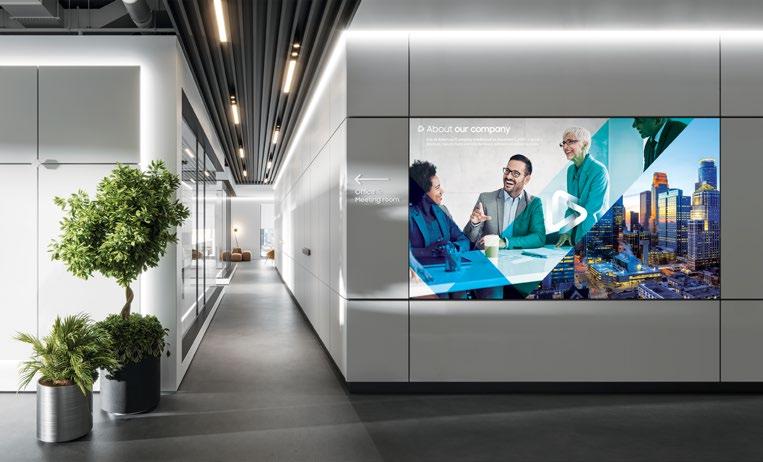
Audinate’s Dante AV-A, designed for the ASPEED AST1530/1535 SoC (System on Chip), delivers high-quality video up to 4Kp60 4:4:4 resolution and two channels of Dante audio that are instantly compatible with Dante audio products, simplifying distributed AV system design. Independently routable audio and video flows mean breaking out audio to installed DSPs, amps, or speakers is done with a single click. It’s ultra-low video latency looks and feels natural for in-room video distribution. Nine leading manufacturing partners have licensed Dante AV-A including AMX by Harman, Aurora Multimedia, AVPro Global, Cypress, GoMax, HDCVT, ProAVIT, SY Electronics, and WyreStorm.
audinate.com
 7 C2G50348 AV Controller
7 C2G50348 AV Controller
Crestron’s VC-4 Virtual Control software-based control platform enables organizations to unify and control a growing number of devices intelligently and efficiently. VC-4 complements industryleading Crestron hardware control systems, bringing together the functionality of Crestron industry-leading hardware control systems with more scalability.
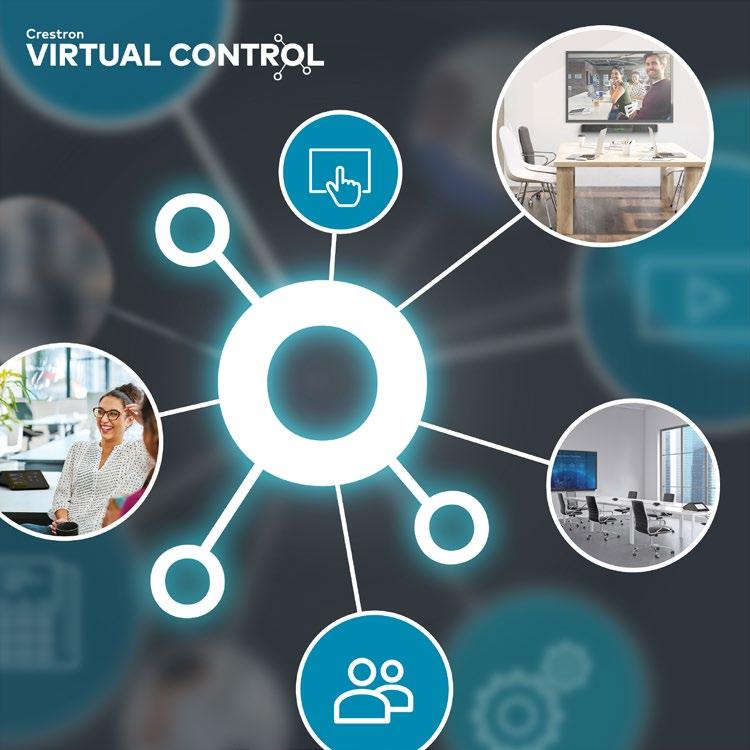
VC-4 is uniquely designed to support organizations that want to deploy and manage presentation rooms, conference rooms, or classrooms at scale and run up to 500 rooms on a single server. It can store standard and customized room configurations in the program library and then, with the push of a button, provision one or dozens of rooms remotely.
crestron.com
Black Box’s MCX delivers the video quality high-end AV applications require to display eye-catching content. MCX installs behind the scenes to distribute and extend true 4K 60Hz
4:4:4 uncompressed video and crystal-clear audio over IP and over your 10Gbps (highspeed) network to an unlimited number of displays with zero source-to-display latency and seamless switching, without sacrificing bandwidth. Add ControlBridge to enable operators to trigger MCX and control room systems via an intuitive touch panel GUI or even mobile devices. In control rooms, as IP is easy to deploy, MCX reduces cabling and breaks distance limitations of proprietary solutions.
blackbox.com
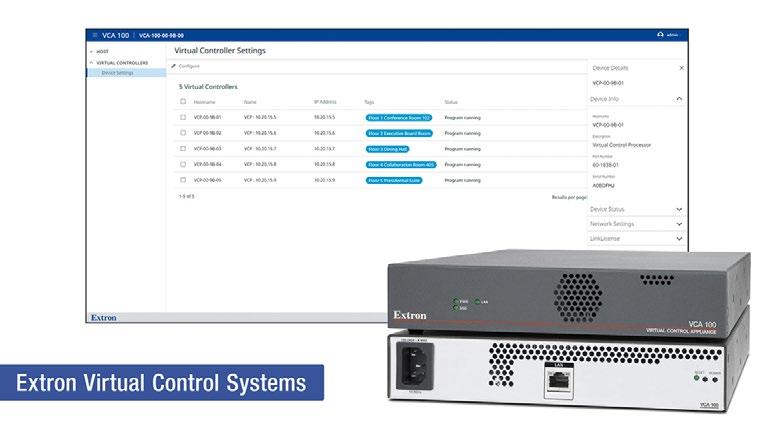
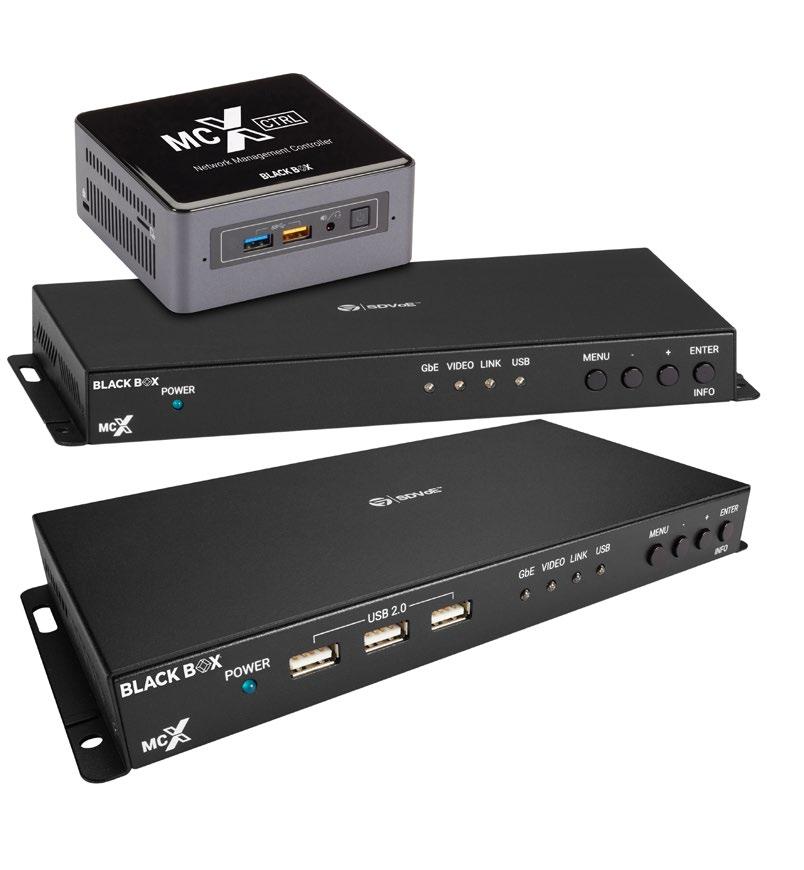
Extron’s VCA 100 Virtual Control Appliance has integrated virtual control processors (VCPs) designed for centralized AV control across your campus or enterprise. The VCA 100 is a powerful appliance that hosts dozens of IPCP Pro xi Series virtual control processors in a single device. Easily deploy these VCPs on your network, then add as many traditional control ports and user interfaces as needed by integrating control system expansion interfaces, TouchLink Pro touchpanels, and network button panels. Organizations will value the benefits of virtual control systems that are easy and fast to deploy, scale, and centrally manage.
extron.com
Middle Atlantic’s RackLink Cloud, brought to you in partnership with Xyte, offers devicelevel control with the industry’s premier remote power management system. With RackLink Cloud you can reduce truck rolls, eliminate on-site visits for routine tasks, optimize workforce allocation, and achieve significant cost savings. Experience faster troubleshooting, proactive maintenance, recurring revenue opportunities, and improved uptime for your clients’ systems.
With RackLink Cloud, there is no extra equipment needed. It lets you monitor and manage your Premium+ PDUs from anywhere in the world without the need for additional network devices. Simply update the firmware to integrate RackLink Cloud directly into the Premium+ PDUs.
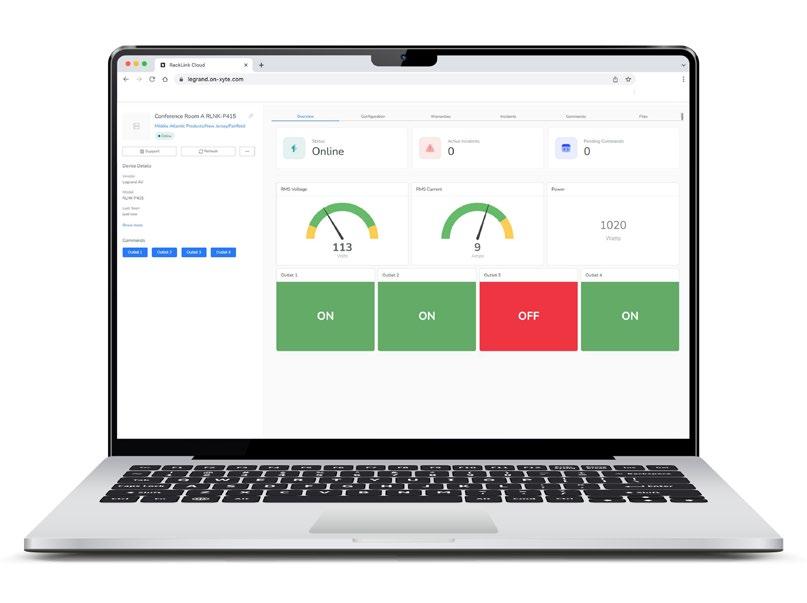
legrandav.com
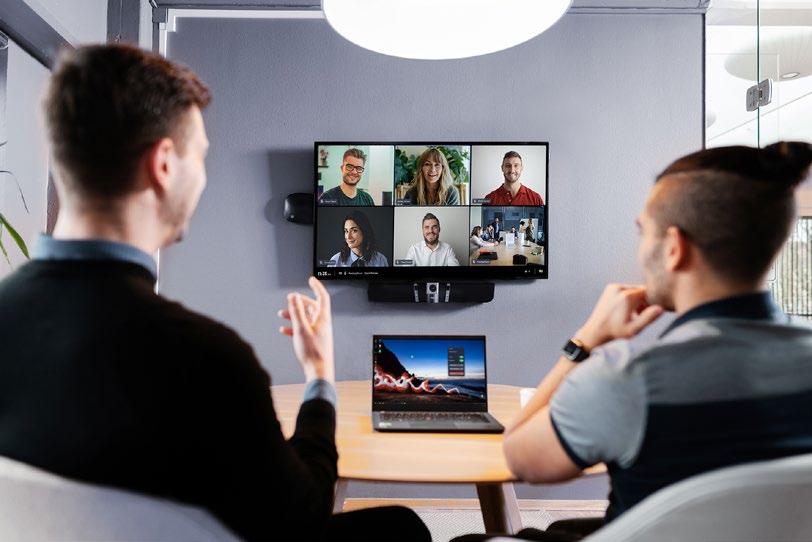
Airtame’s Hybrid Conferencing Hub, within the Airtame platform, integrates digital signage and video conferencing solutions. It combines the quality and stability of traditional Rooms systems with the flexibility of BYOM solutions. An industry-disrupting conferencing platform compatible with many popular video conferencing solutions, it is a powerful tool for transforming offices into modern hybrid work environments.
Airtame’s Hybrid Conferencing Hub has a number of unique features, including Share to Call functionality, which allows any person in a meeting room to instantly share their screen into a call without joining from a personal device. Through accessible screen sharing for in-room and remote participants, Airtame Hybrid Conferencing Hub boosts meeting equity and simplicity.
airtame.com
SurgeX’s CONNECT is an advanced cloud-based software that simplifies the management of compatible SurgeX devices for integrators. With its centralized hub, integrators can easily diagnose power quality issues and monitor installations from anywhere. The platform’s intuitive and secure dashboard enables remote control of outlets and devices, empowering integrators to meet power quality requirements across all project sites confidently. SurgeX CONNECT delivers a seamless and superior experience through its robust connectivity, comprehensive device management, remote monitoring, and advanced analytics— all backed by SurgeX’s trusted power protection technologies. ametekesp.com
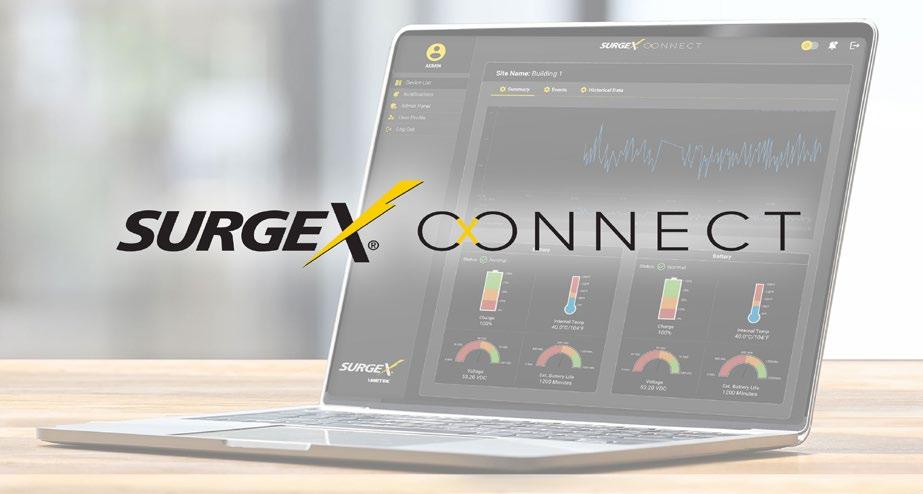
BenQ’s X-Sign Software turns any display into signage or a broadcast system. X-Sign offers a comprehensive yet simple way to create, manage, and display engaging content and can serve as a wireless broadcast system that pushes instant and scheduled alerts, messages, and announcements. The cloud-based content management software offers hundreds of pre-made templates, the ability to send videos and text, as well as the ability to schedule distribution and monitor performance of content in real time. Users can choose to send content to one display, select screens, or to a whole organization. The all-in-one software reduces costs and saves resources.
benq.com

ATEN Technology’s VK2200 Control Box with Dual LAN boasts a quad-core CPU and 2GB memory to provide real-time response and status updates and can process complex, high-loading events with customized GUI designs, as well as multiuser access control to connected devices. The VK2200 features dual, isolated LAN ports. The Control LAN allows managed devices to be securely protected within a separate network, independent from the corporate network, for fulfilling highsecurity and stability demand. The other LAN port can be connected to ATEN UNIZON, a centralized platform streamlining daily AV/IT management, for convenience in monitoring, troubleshooting, and maintaining multiple systems all at once.
aten.com
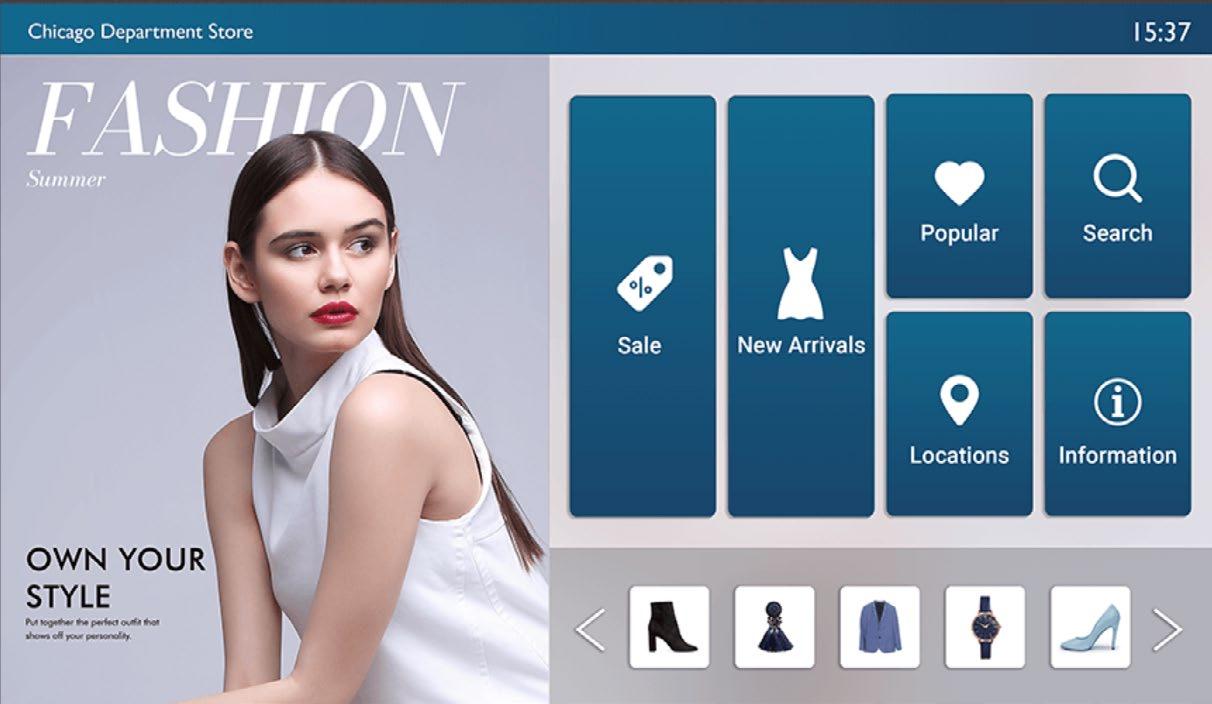
RTI’s KX4 Touchpanel, combining a 4-inch in-wall touchpanel and hard-buttons with a built-in control processor, is ideal for single-room commercial applications such as meeting rooms, classrooms, and lecture halls. The result is an enhanced automation solution that combines RTI’s control power with installation simplicity in a single costeffective unit. For users, it dispels any anxiety caused by operating technology. The integrator can program the unit’s five hard buttons for the most-used functions, such as volume or lighting control, while the touchscreen interface provides even more customized options, such as a “start class” button programmed for more efficient lectures, presentations, and remote classes.
rticontrol.com
Want to find out more about the latest products and tech? Simply click here to visit the AVT website and access your ultimate product guide.
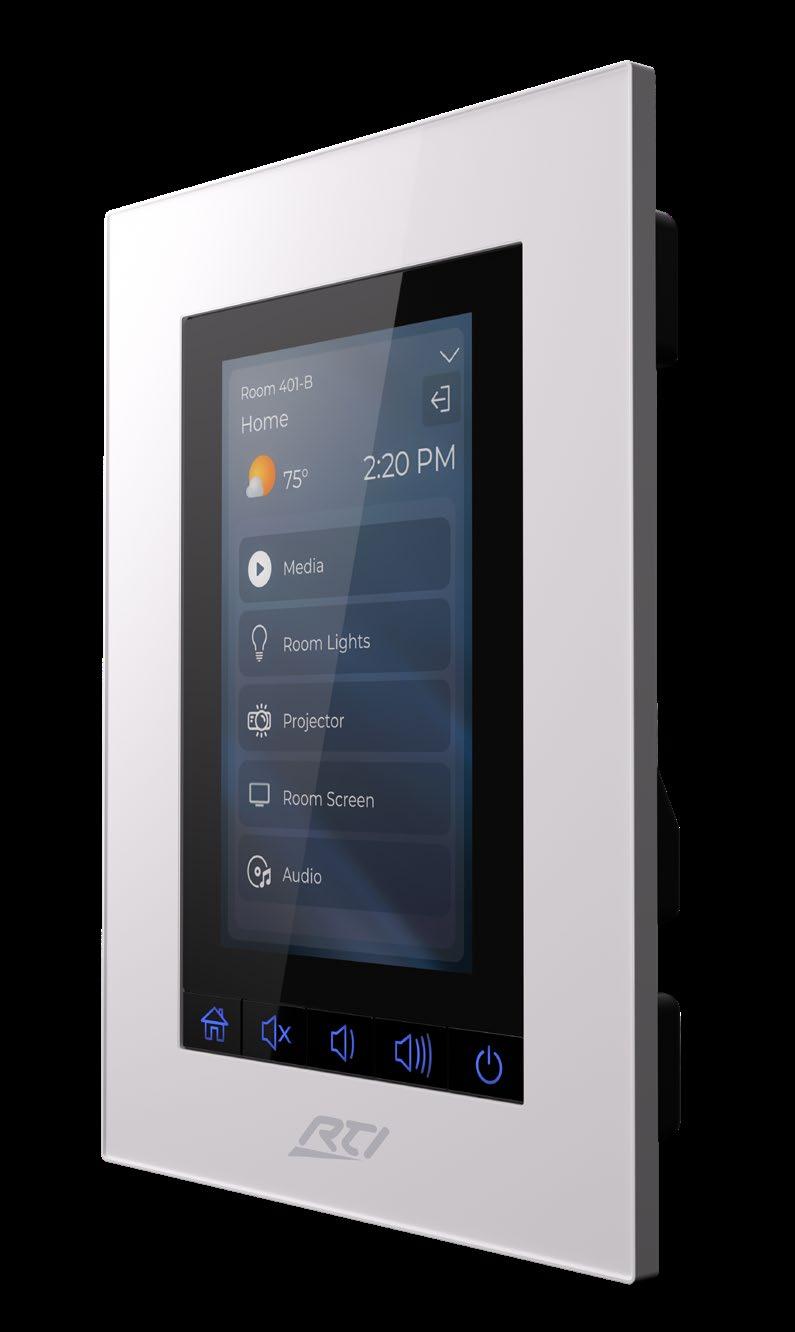
FURNITURE FLYPACKS AND ROAD CASES
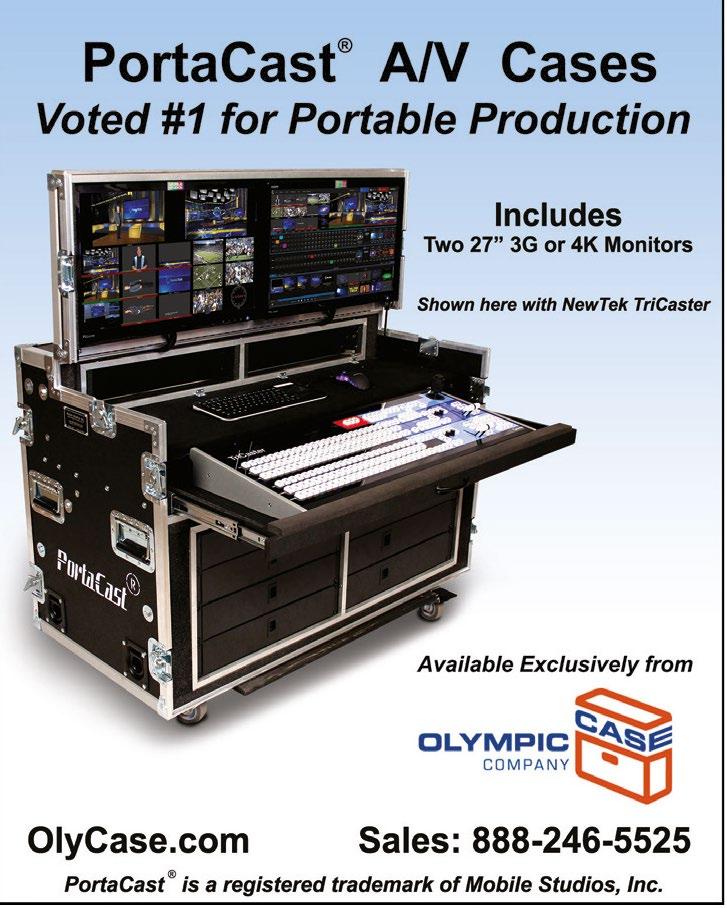
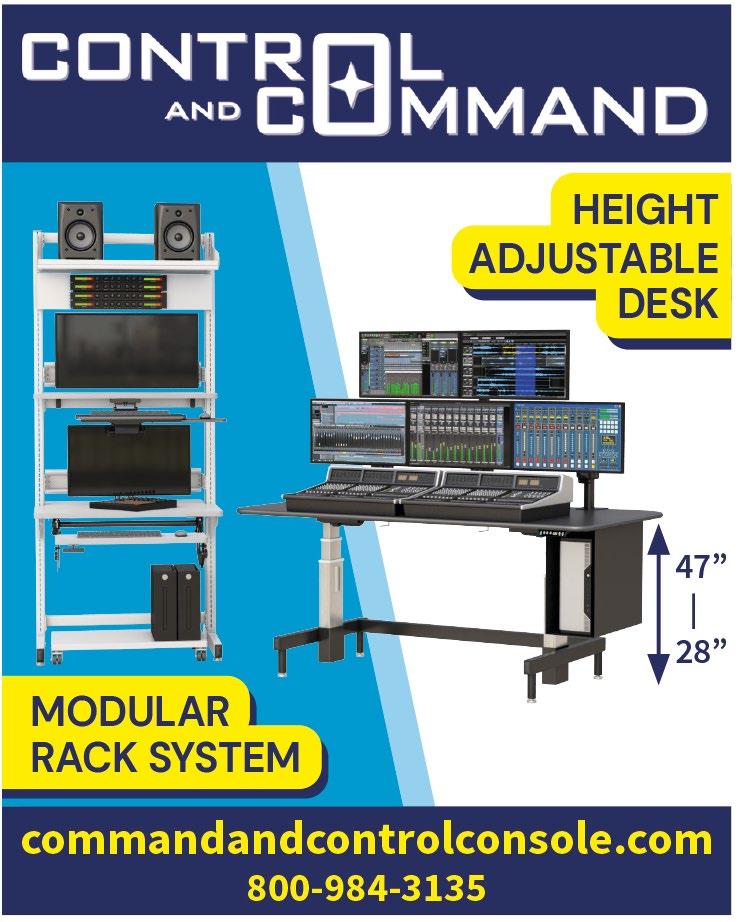
ADVERTISE WITH US:
WITH AVNETWORKS FREE ELECTRONIC NEWSLETTERS
ONE-STOP SHOPPING: simply visit www.avnetwork.com/news/subscribe and click on as many newsletters as you need.
OR CLICK HERE
For more information on advertising in the next issue of AVTechnology, please contact Zahra.Majma@Futurenet.com
